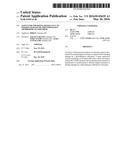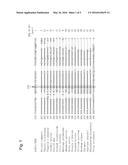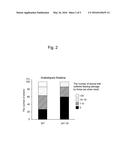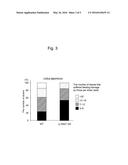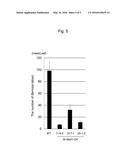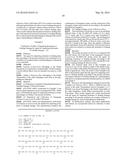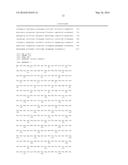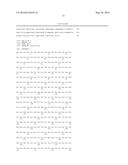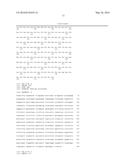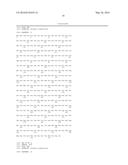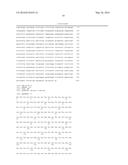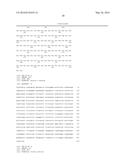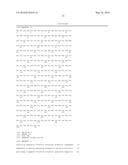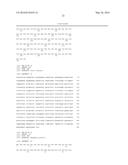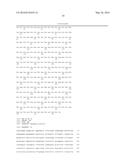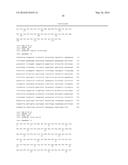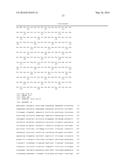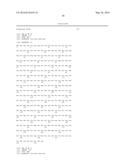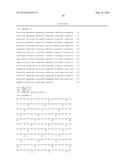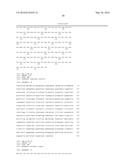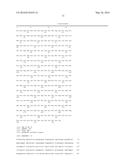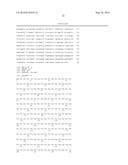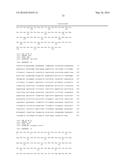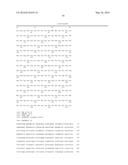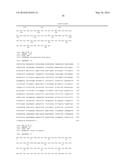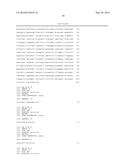Patent application title: AGENT FOR IMPARTING RESISTANCE TO FEEDING DAMAGE BY PHYTOPHAGOUS ARTHROPOD (As Amended)
Inventors:
Takeshi Nakano (Saitama, JP)
Tadao Asami (Saitama, JP)
Ayumi Yamagami (Saitama, JP)
IPC8 Class: AC12N1582FI
USPC Class:
800302
Class name: Plant, seedling, plant seed, or plant part, per se higher plant, seedling, plant seed, or plant part (i.e., angiosperms or gymnosperms) insect resistant plant which is transgenic or mutant
Publication date: 2016-05-26
Patent application number: 20160145639
Abstract:
An object of the present invention is to develop and provide a method for
enhancing the resistance of a plant itself to feeding damage by a
phytophagous arthropod. A gene expression system containing, in an
expressible state, a gene encoding a variant BIL1/BZR1 protein with a
particular point mutation is transferred to a desired plant to thereby
impart resistance to feeding damage by a phytophagous arthropod to the
plant.Claims:
1. An agent for imparting resistance to feeding damage by a phytophagous
arthropod, comprising a polypeptide represented by any of the following
amino acid sequences (a) to (c) or an active fragment thereof: (a) a
polypeptide in which proline (P) at position 234 in the amino acid
sequence shown in SEQ ID NO: 1 is substituted by leucine (L), (b) a
polypeptide comprising an amino acid sequence derived from the
polypeptide (a) by the deletion, substitution, or addition of one or
several amino acids except for leucine at position 234, and (c) a
polypeptide having 60% or more amino acid identity to the polypeptide
(a).
2. An agent for imparting resistance to feeding damage by a phytophagous arthropod, comprising a gene expression system containing, in an expressible state, a nucleic acid encoding a polypeptide represented by any of amino acid sequences (a) to (c) or an active fragment thereof according to claim 1.
3. An agent for imparting resistance to feeding damage by a phytophagous arthropod, comprising a gene expression system containing, in an expressible state, a nucleic acid represented by any of the following nucleotide sequences (d) to (g) or an active fragment thereof: (d) a polynucleotide in which cytosine (C) at position 701 in the nucleotide sequence shown in SEQ ID NO: 2 is substituted by thymine (T), (e) a polynucleotide comprising a nucleotide sequence derived from the polynucleotide (d) by the deletion, substitution, or addition of one or several bases except for thymine at position 701, (f) a polynucleotide having 60% or more base identity to the polynucleotide (d), and (g) a polynucleotide hybridizing under stringent conditions to a nucleotide sequence complementary to the polynucleotide (d).
4. The agent for imparting resistance to feeding damage according to claim 2, wherein the gene expression system is overexpression type, constitutively active type, inducible expression type, or a combination thereof for the contained nucleic acid.
5. The agent for imparting resistance to feeding damage according to claim 1, wherein the phytophagous arthropod is a phytophagous insect.
6. The agent for imparting resistance to feeding damage according to claim 5, wherein the phytophagous insect is a species belonging to the order Thysanoptera or the family Aleyrodidae.
7. The agent for imparting resistance to feeding damage according to claim 1, wherein the agent is intended for a dicotyledon.
8. A method for imparting resistance to feeding damage by a phytophagous arthropod to a plant, comprising administering an agent for imparting resistance to feeding damage according to claim 1 to a desired plant.
9. A plant resistant to feeding damage by a phytophagous arthropod and progeny thereof, comprising a gene expression system containing, in an expressible state, a nucleic acid encoding a polypeptide represented by any of the following amino acid sequences (a) to (c) or an active fragment thereof: (a) a polypeptide in which proline (P) at position 234 in the amino acid sequence shown in SEQ ID NO: 1 is substituted by leucine (L), (b) a polypeptide comprising an amino acid sequence derived from the polypeptide (a) by the deletion, substitution, or addition of one or several amino acids except for leucine at position 234, and (c) a polypeptide having 60% or more amino acid identity to the polypeptide (a).
10. A plant resistant to feeding damage by a phytophagous arthropod and progeny thereof, comprising a gene expression system containing, in an expressible state, a nucleic acid represented by any of the following nucleotide sequences (d) to (g) or an active fragment thereof: (d) a polynucleotide in which cytosine (C) at position 701 in the nucleotide sequence shown in SEQ ID NO: 2 is substituted by thymine (T), (e) a polynucleotide comprising a nucleotide sequence derived from the polynucleotide (d) by the deletion, substitution, or addition of one or several bases except for thymine at position 701, (f) a polynucleotide having 60% or more base identity to the polynucleotide (d), and (g) a polynucleotide hybridizing under stringent conditions to a nucleotide sequence complementary to the polynucleotide (d).
11. The plant resistant to feeding damage and the progeny thereof according to claim 9, wherein the gene expression system is overexpression type, constitutively active type, inducible expression type, or a combination thereof for the contained nucleic acid.
12. The plant resistant to feeding damage and the progeny thereof according to claim 9, wherein the phytophagous arthropod is a phytophagous insect.
13. The plant resistant to feeding damage and the progeny thereof according to claim 12, wherein the phytophagous insect is a species belonging to the order Thysanoptera or the family Aleyrodidae.
14. The plant resistant to feeding damage and the progeny thereof according to any claim 9, wherein the desired plant is a dicotyledon.
Description:
TECHNICAL FIELD
[0001] The present invention relates to an agent for imparting resistance to feeding damage by a phytophagous arthropod, a method for imparting resistance to feeding damage by a phytophagous arthropod to a plant, and a plant resistant to feeding damage by a phytophagous arthropod.
BACKGROUND ART
[0002] In the cultivation of crops, feeding damage by phytophagous arthropods, i.e., so-called agricultural pests, brings about serious problems, such as reduction in the yields of crops and the spread of plant diseases mediated by microbes or viruses, to the agricultural field. Hence, the control or extermination of agricultural pests is an agriculturally important challenge.
[0003] In the past, the application of chemical pesticides has mainly been practiced for the control or extermination of agricultural pests. The control using chemical pesticides, however, presents major problems such as the emergence of drug-resistant individuals, insecticidal action on useful insects, environmental pollutions, and residues on crops. Particularly, a shift to a sustained control technique in consonance with the environment has been demanded in response to increasing environmental consciousness in recent years. Thus, alternative control techniques for chemical pesticides have been received attention.
[0004] Typical examples thereof include biological control. The biological control is a method for controlling or exterminating agricultural pests, pathogenic microbes, or weed, etc., by use of natural enemies as biological pesticides (natural enemy preparations) based on a prey-predator relationship or a host-parasite relationship in the native ecosystem.
[0005] For example, Amblyseius swirskii and Orius strigicollis are used as natural enemies for biological control for thrips known as a difficult-to-control pest to cause serious damage to various crops. Amblyseius swirskii, however, is less active at low temperatures and preys thrips in reduced amounts, disadvantageously resulting in significant reduction in control effect. On the other hand, Orius strigicollis is effective in that it can be active at low temperatures and preys thrips in large amounts. However, its initial rate of colonization or rate of proliferation after pasturing is low (Non Patent Literature 1).
[0006] In order to solve this problem, a method exploiting insectary plants that promote the colonization or propagation of natural enemies for biological control has been developed (Non Patent Literature 2). The insectary plants, also called natural enemy-fostering plants, can enhance the rate of colonization or proliferation of natural enemies on crops by providing environmental conditions that facilitate the working of the natural enemies.
[0007] However, the introduction of insectary plants further increases cost for the biological control, which generally requires higher cost than that of the chemical control. In addition, the cultivation management of insectary plants themselves in addition to crops is necessary. Thus, there has arisen the new problem that a large amount of labor is required.
[0008] Hence, it has been desired to develop a novel technique that facilitates management at low cost and is capable of further effectively controlling or exterminating agricultural pests.
CITATION LIST
Non Patent Literature
[0009] Non Patent Literature 1: Kazuki Kakimoto et al., 2007, Japanese Journal of Applied Entomology and Zoology 51 (1): 29-37.
[0010] Non Patent Literature 2: Kazuya Nagai and Mitsuharu Hikawa, 2012, Japanese Journal of Applied Entomology and Zoology 56 (2): 57-64.
SUMMARY OF INVENTION
Technical Problem
[0011] An object of the present invention is to develop and provide a method for enhancing the resistance of a plant itself to feeding damage by a phytophagous arthropod without depending on chemical pesticides or biological pesticides.
Solution to Problem
[0012] To attain the object, the present inventors have tackled the development of, not methods based on external factors such as chemical pesticides or biological pesticides, but a method for preventing feeding damage by agricultural pests by enhancing the properties of plants themselves, i.e., their pest-repellent effects. As a result, the present inventors have found that when a particular mutant gene of BIL1/BZR1 gene is expressed in plant cells, the plant acquires strong resistance to feeding damage by phytophagous arthropods such as thrips and whitefly known as a difficult-to-control pest. The BIL1/BZR1 protein is a protein that functions as a transcriptional factor downstream of the brassinosteroid signaling pathway (BR signaling pathway). Brassinosteroid is known as a plant hormone that is involved in plant growth regulation, photomorphogenesis, vascular bundle formation control, chloroplast functional regulation, etc. (Azpiroz R. et al., 1988, Plant Cell, 10: 219-230; Clouse S. & Sasse J., 1998, Annu. Rev. Plant Physiol. Plant Mol. Biol., 49: 427-45; Mandava N., 1988, Annu. Rev. Plant Physiol. Plant Mol. Biol., 39: 23-52; and Sakurai A. et al., 1999, Brassinosteroids, Steroidal Plant Hormones, Tokyo: Springer). Brassinosteroid has already been known to participate in the induction of disease resistance (brassinosteroid-mediated disease resistance; BDR) and impart plant disease resistance to plants by enhancing the intracellular signal transduction of brassinosteroid (Nakashita et al., 2003, Plant Journal, 33: 887-98). However, resistance to plant diseases caused by microbial infection and feeding damage control by repellent effects on phytophagous arthropods are considered to function under totally different mechanisms from the plant physiological standpoint. In fact, the BIL1/BZR1 protein is known to control development (Wang et al., 2002, Developmental Cell, 2: 505-513), but cannot induce plant disease resistance, unlike other brassinosteroid signaling factors (W02012/077786).
[0013] The present inventors have further found that when a bil1/bzr1 mutant gene of Arabidopsis thaliana of the family Brassicaceae is transferred to Lotus japonicus of the family Leguminosae or Solanum lycopersicum of the family Solanaceae, the resulting transformed plant can acquire resistance to feeding damage similar to that of Arabidopsis thaliana, and revealed that the bil1/bzr1 mutant gene can impart resistance to feeding damage by a phytophagous arthropod to a wide range of plants beyond species. The present invention is based on these new findings and provides the following:
[0014] (1) An agent for imparting resistance to feeding damage by a phytophagous arthropod, the agent comprising a polypeptide represented by any of the following amino acid sequences (a) to (c) or an active fragment thereof:
[0015] (a) a polypeptide in which proline (P) at position 234 in the amino acid sequence shown in SEQ ID NO: 1 is substituted by leucine (L),
[0016] (b) a polypeptide comprising an amino acid sequence derived from the polypeptide (a) by the deletion, substitution, or addition of one or several amino acids except for leucine at position 234, and
[0017] (c) a polypeptide having 60% or more amino acid identity to the polypeptide (a).
[0018] (2) An agent for imparting resistance to feeding damage by a phytophagous arthropod, the agent comprising a gene expression system containing, in an expressible state, a nucleic acid encoding a polypeptide represented by any of amino acid sequences (a) to (c) or an active fragment thereof according to (1).
[0019] (3) An agent for imparting resistance to feeding damage by a phytophagous arthropod, the agent comprising a gene expression system containing, in an expressible state, a nucleic acid represented by any of the following nucleotide sequences (d) to (g) or an active fragment thereof:
[0020] (d) a polynucleotide in which cytosine (C) at position 701 in the nucleotide sequence shown in SEQ ID NO: 2 is substituted by thymine (T),
[0021] (e) a polynucleotide comprising a nucleotide sequence derived from the polynucleotide (d) by the deletion, substitution, or addition of one or several bases except for thymine at position 701,
[0022] (f) a polynucleotide having 60% or more base identity to the polynucleotide (d), and
[0023] (g) a polynucleotide hybridizing under stringent conditions to a nucleotide sequence complementary to the polynucleotide (d).
[0024] (4) The agent for imparting resistance to feeding damage according to (2) or (3), wherein the gene expression system is overexpression type, constitutively active type, inducible expression type, or a combination thereof for the contained nucleic acid.
[0025] (5) The agent for imparting resistance to feeding damage according to any of (1) to (4), wherein the phytophagous arthropod is a phytophagous insect.
[0026] (6) The agent for imparting resistance to feeding damage according to (5), wherein the phytophagous insect is a species belonging to the order Thysanoptera or the family Aleyrodidae.
[0027] (7) The agent for imparting resistance to feeding damage according to any of (1) to (6), wherein the agent is intended for a dicotyledon.
[0028] (8) A method for imparting resistance to feeding damage by a phytophagous arthropod to a plant, the method comprising administering an agent for imparting resistance to feeding damage according to any of (1) to (7) to a desired plant.
[0029] (9) A plant resistant to feeding damage by a phytophagous arthropod and progeny thereof, the plant and the progeny each comprising a gene expression system containing, in an expressible state, a nucleic acid encoding a polypeptide represented by any of the following amino acid sequences (a) to (c) or an active fragment thereof:
[0030] (a) a polypeptide in which proline (P) at position 234 in the amino acid sequence shown in SEQ ID NO: 1 is substituted by leucine (L),
[0031] (b) a polypeptide comprising an amino acid sequence derived from the polypeptide (a) by the deletion, substitution, or addition of one or several amino acids except for leucine at position 234, and
[0032] (c) a polypeptide having 60% or more amino acid identity to the polypeptide (a).
[0033] (10) A plant resistant to feeding damage by a phytophagous arthropod and progeny thereof, the plant and the progeny each comprising a gene expression system containing, in an expressible state, a nucleic acid represented by any of the following nucleotide sequences (d) to (g) or an active fragment thereof:
[0034] (d) a polynucleotide in which cytosine (C) at position 701 in the nucleotide sequence shown in SEQ ID NO: 2 is substituted by thymine (T),
[0035] (e) a polynucleotide comprising a nucleotide sequence derived from the polynucleotide (d) by the deletion, substitution, or addition of one or several bases except for thymine at position 701,
[0036] (f) a polynucleotide having 60% or more base identity to the polynucleotide (d), and
[0037] (g) a polynucleotide hybridizing under stringent conditions to a nucleotide sequence complementary to the polynucleotide (d).
[0038] (11) The plant resistant to feeding damage and the progeny thereof according to (9) or (10), wherein the gene expression system is overexpression type, constitutively active type, inducible expression type, or a combination thereof for the contained nucleic acid.
[0039] (12) The plant resistant to feeding damage and the progeny thereof according to any of (9) to (11), wherein the phytophagous arthropod is a phytophagous insect.
[0040] (13) The plant resistant to feeding damage and the progeny thereof according to (12), wherein the phytophagous insect is a species belonging to the order Thysanoptera or the family Aleyrodidae.
[0041] (14) The plant resistant to feeding damage and the progeny thereof according to any of (9) to (13), wherein the desired plant is a dicotyledon.
[0042] The present specification encompasses the contents described in the specification and/or drawings of Japanese Patent Application No. 2013-130971, on which the priority of the present application is based.
Advantageous Effects of Invention
[0043] The agent for imparting resistance to feeding damage according to the present invention can be administered to a desired plant to thereby impart resistance to feeding damage by a phytophagous arthropod to the plant.
[0044] The method for imparting resistance to feeding damage by a phytophagous arthropod to a plant according to the present invention is capable of conveniently imparting resistance to feeding damage by a phytophagous arthropod to a desired plant. As a result, a plant resistant to feeding damage by a phytophagous arthropod can be easily produced.
[0045] The plant resistant to feeding damage and the progeny thereof according to the present invention can provide a plant that has acquired sustained resistance to feeding damage by a phytophagous arthropod, without the need of special management or cost.
BRIEF DESCRIPTION OF DRAWINGS
[0046] FIG. 1 is a diagram showing the alignment of the amino acid sequences of Arabidopsis thaliana BIL1/BZR1 protein (AtBIL1/BZR1) and an AtBIL1/BZR1 protein ortholog of each plant species in the particular mutation of the present invention and its neighboring regions. In the AtBIL1/BZR1 protein ortholog, portions having amino acids identical to those of the AtBIL1/BZR1 protein after the alignment are indicated by asterisks. The hyphens represent gaps. The numeric value on the left side of each amino acid sequence represents the position of the N-terminal amino acid from initiating methionine defined as position 1 in each full-length protein represented by SEQ ID NO on the right side of each amino acid sequence. A P234L-AtBIL1/BZR1 protein in which the boxed proline (P) corresponding to position 234 in the AtBIL1/BZR1 protein was point-mutated to leucine (L), and an ortholog mutated therefrom are variant BIL1/BZR1 proteins which are subject to the present invention.
[0047] FIG. 2 is a diagram showing that an Arabidopsis thaliana bil1-1D strain with a P234L-Atbil1 gene, which corresponds to the plant resistant to feeding damage of the present invention, has resistance to feeding damage by Thrips tabaci. After an experiment, the number of leaves found to have feeding signs per strain was counted. The test strains were classified according to the number of leaves that suffered feeding damage, and evaluated for their feeding damage statuses on the basis of the ratio of each group to the total number of test strains.
[0048] FIG. 3 is a diagram showing that a gene expression system containing a P234L-Atbil1 gene, which is the agent for imparting resistance to feeding damage according to the present invention, was administered to a wild strain of Lotus japonicus different from Arabidopsis thaliana that was a species of the origin of the P234L-Atbil1 gene, and the obtained transgenic Lotus japonicus Lj-Atbil1-OX strain acquired resistance to feeding damage by Thrips tabaci.
[0049] FIG. 4 is a diagram showing that an Arabidopsis thaliana bil1-1D strain with a P234L-Atbil1 gene, which corresponds to the plant resistant to feeding damage of the present invention, has resistance to feeding damage by Frankliniella occidentalis. In order to show the feeding damage status, a wild strain (for a control) and the bil1-1D strain were photographed from above after an experiment.
[0050] FIG. 5 is a diagram showing that a gene expression system containing a P234L-Atbil1 gene was administered to a wild strain of Solanum lycopersicum, and the obtained transgenic Solanum lycopersicum Sl-Atbil1-OX strain acquired resistance to feeding damage by Bemisia tabaci.
DESCRIPTION OF EMBODIMENTS
[0051] 1. Agent for Imparting Resistance to Feeding Damage
[0052] 1-1. Summary
[0053] The first aspect of the present invention is an agent for imparting resistance to feeding damage. The agent for imparting resistance to feeding damage according to this aspect is a preparation that can be administered to a desired plant to thereby impart resistance to feeding damage by a phytophagous arthropod to the plant.
[0054] 1-2. Definition
[0055] In the present specification, the "resistance to feeding damage" refers to the property of being insusceptible or less susceptible to feeding damage by a phytophagous arthropod through a repellent effect on the phytophagous arthropod.
[0056] In the present specification, the "phytophagous arthropod" refers to an arthropod that ingests a living plant body. In the present specification, the phytophagous arthropod particularly corresponds to an agricultural pest that causes damage to various crops including vegetables, fruit trees, flowers, and tea. Specific examples of the phytophagous arthropod include phytophagous insects and species belonging to the family Tetranychidae. The phytophagous insects which are subject to the present invention include, for example, species belonging to the order Thysanoptera, species belonging to the suborder Heteroptera, species belonging to the superfamily Aphidoidea, species belonging to the family Aleyrodidae, species belonging to the superfamily Coccoidea, species belonging to the suborder Symphyta, and species belonging to the order Lepidoptera. Species belonging to the order Thysanoptera and species belonging to the family Aleyrodidae known as difficult-to-control pests are preferred.
[0057] In the present specification, the species belonging to the order Thysanoptera include, for example, Thrips tabaci, Frankliniella occidentalis, Frankliniella intonsa, Henothrips haemorrhoidalis, Thrips palmi, Thrips nigropilosus, and Scirtothrips dorsalis.
[0058] In the present specification, the species belonging to the suborder Heteroptera include Megacopta punctatissima, Nezara antennata, Halyomorpha halys, Eurydema rugosa, Glaucias subpunctatus, Stephanitis pyrioides, Stephanitis nashi, Stephanitis typica, and Galeatus spinifrons.
[0059] In the present specification, the species belonging to the superfamily Aphidoidea include, for example, Aphis gossypii, Aphis glycines, Aphis craccivora, Acyrthosiphon pisum, Aphis forbesi, Aphis spiraecola, Myzus persicae, Rhodobium porosum, Rhopalosiphum rufiabdominalis, Brevicoryne brassicae, Lipaphis erysimi ,Neotoxoptera formosana, Uroleucon formosanum, Chaetosiphon fragaefolii, Macrosiphum euphorbiae, Rhopalosiphum maidis, Rhopalosiphum padi, Sitobion akebiae, Aulacorthum solani, Toxoptera citricida, Ovatus malisuctus, and Hyalopterus pruni.
[0060] In the present specification, the species belonging to the family Aleyrodidae include, for example, Bemisia tabaci, Bemisia argentifolii, Trialeurodes vaporariorum, and Aleurocanthus spiniferus .
[0061] In the present specification, the species belonging to the superfamily Coccoidea include, for example, Icerya purchasi Maskell, Ceroplastes rubens, and Eulecanium kunoense.
[0062] In the present specification, the species belonging to the family Tetranychidae include, for example, Tetranychus urticae, Tetranychus kanzawai, Amphitetranychus viennensis, Panonychus citri, Panonychus ulmi, and Bryobia praetiosa.
[0063] The site to be ingested by the phytophagous arthropod in the plant body is not limited. The site to be ingested may be, for example, any of leaves, flowers, stems, roots, shoots, fruits, and seeds. The form of ingestion by the phytophagous arthropod is not limited. The form of ingestion may be the direct ingestion of the plant body or may be the sucking of a plant body fluid through the insertion of snout or the like into the plant body.
[0064] In the present specification, the "administration to a desired plant" refers to the contact or introduction of the agent for imparting resistance to feeding damage with or to the desired plant to which resistance to feeding damage is to be imparted, when the agent for imparting resistance to feeding damage comprises a particular variant BIL1/BZR1 protein or an active fragment thereof. Specific examples of the contact or the introduction include nebulization, spraying, coating, and dipping. Alternatively, the "administration to a desired plant" refers to the introduction of a gene expression system into the desired plant cells, when the agent for imparting resistance to feeding damage comprises the gene expression system. The desired plant will be described in detail in the second aspect, so that the description thereof is omitted here.
[0065] 1-3. Configuration
[0066] The agent for imparting resistance to feeding damage according to this aspect comprises a particular variant BIL1/BZR1 protein or an active fragment thereof, or a gene expression system containing, in an expressible state, a nucleic acid encoding the protein or the active fragment.
[0067] (1) Particular Variant BIL1/BZR1 Protein or Active Fragment Thereof
[0068] The "BIL1/BZR1 protein" is a factor that functions as a downstream transcriptional factor in the intracellular brassinosteroid signaling pathway. BZR1 is a synonym for BIL1. In the present specification, only BIL1 shall therefore be used below.
[0069] The "particular variant BIL1 protein" is a variant BIL1 protein having a point mutation by which proline (P) at position 234 with initiating methionine defined as position 1 is substituted by leucine (L), for example, in the case of an amino acid sequence constituting the Arabidopsis thaliana wild-type BIL1 protein (hereinafter, also referred to as an "AtBIL1 protein") shown in SEQ ID NO: 1. In the present specification, this point mutation is referred to as "P234L", and a variant AtBIL1 protein having P234L is indicated by a "P234L-AtBIL1 protein". This P234L point mutation in the AtBIL1 protein is a gain-of-function mutation that stabilizes the AtBIL1 protein and brings about the high accumulation thereof in cells. Although the specific mechanism is unknown, Examples mentioned later have demonstrated that a plant expressing the P234L-AtBIL1 protein can acquire resistance to feeding damage by a phytophagous arthropod.
[0070] The "particular variant BIL1 protein" may be not only the P234L-AtBIL1 protein but a variant BIL1 protein having a mutation equivalent to P234L in any of AtBIL1 protein orthologs of other plant species. The "AtBIL1 protein orthologs" refer to a group of proteins having the same functions as those of the AtBIL1 protein in other plant species. The "mutation equivalent to P234L" refers to a point mutation by which P that corresponds to position 234 of the AtBIL1 protein when the amino acid sequences of each AtBIL1 protein ortholog and the AtBIL1 protein are aligned, and is highly conserved among species (FIG. 1) is substituted by L. Specific examples thereof include a polypeptide in which P at position 221 in Ricinus communis BIL1protein (RcBIL1 protein) shown in SEQ ID NO: 3 is substituted by L (P221L-RcBIL1 protein), a polypeptide in which P at position 216 in Fragaria×ananassa BIL1 protein (FaBIL1 protein) shown in SEQ ID NO: 5 is substituted by L (P216L-FaBIL1 protein), a polypeptide in which P at position 219 in Glycine max BIL1 protein (GmBIL1 protein) shown in SEQ ID NO: 7 is substituted by L (P219L-GmBIL1 protein), a polypeptide in which P at position 219 in Medicago polymorpha BIL1 protein (MpBIL1 protein) shown in SEQ ID NO: 9 is substituted by L (P219L-MpBIL1 protein), a polypeptide in which P at position 239 in Solanum lycopersicum BIL1 protein (SlBIL1 protein) shown in SEQ ID NO: 11 is substituted by L (P239L-S1BIL1 protein), a polypeptide in which P at position 215 in Petunia×hybrida BIL1 protein (PhBIL1 protein) shown in SEQ ID NO: 13 is substituted by L (P215L-PhBIL1 protein), a polypeptide in which P at position 214 in Cucumis sativus BIL1 protein (CsBIL1 protein) shown in SEQ ID NO: 15 is substituted by L (P214L-CsBIL1 protein), a polypeptide in which P at position 210 in Vitis vinifera BIL1 protein (VvBIL1 protein) shown in SEQ ID NO: 17 is substituted by L (P210L-VvBIL1 protein), a polypeptide in which P at position 211 in Amygdalus persica BIL1 protein (ApBIL1 protein) shown in SEQ ID NO: 19 is substituted by L (P211L-ApBIL1 protein), a polypeptide in which P at position 219 in Populus trichocarpa BIL1 protein (PtBIL1 protein) shown in SEQ ID NO: 21 is substituted by L (P219L-PtBIL1 protein), a polypeptide in which P at position 212 in Oryza sativa BIL1 protein (OsBIL1 protein) shown in SEQ ID NO: 23 is substituted by L (P212L-OsBIL1 protein), a polypeptide in which P at position 217 in Triticum aestivum BIL1 protein (TaBIL1 protein) shown in SEQ ID NO: 25 is substituted by L (P217L-TaBIL1 protein), a polypeptide in which P at position 218 in Aegilops tauschii BIL1 protein (AetBIL1 protein) shown in SEQ ID NO: 27 is substituted by L (P218L-AetBIL1 protein), a polypeptide in which P at position 222 in Hordeum vulgare BIL1 protein (HvBIL1 protein) shown in SEQ ID NO: 29 is substituted by L (P222L-HvBIL1 protein), a polypeptide in which P at position 228 in Zea mays BIL1 protein (ZmBIL1 protein) shown in SEQ ID NO: 31 is substituted by L (P228L-ZmBIL1 protein), a polypeptide in which P at position 231 in Sorghum bicolor BIL1 protein (SbBIL1 protein) shown in SEQ ID NO: 33 is substituted by L (P231L-SbBIL1 protein), a polypeptide in which P at position 238 in Brachypodium distachyon BIL1 protein (BdBIL1 protein) shown in SEQ ID NO: 35 is substituted by L (P238L-BdBIL1 protein), and a polypeptide in which P at position 215 in Picea sitchensis BIL1 protein (PsBIL1 protein) shown in SEQ ID NO: 38 is substituted by L (P215L-PsBIL1 protein). In the present specification, these variant BIL1 proteins are referred to as "P234L-AtBIL1 protein orthologs".
[0071] The "particular variant BIL1 protein" may have the deletion, substitution, or addition of one or more or several amino acids within a range that maintains the activity of resistance to feeding damage by a phytophagous arthropod, in addition to P234L in the AtBIL1 protein or a point mutation of a P234L counterpart in the P234L-AtBIL1 protein ortholog. In the present specification, the term "several" refers to 2 to 10, 2 to 7, 2 to 5, or 2 to 4. Furthermore, the particular variant BIL1 protein may be a polypeptide that retains P234L of the AtBIL1 protein or a point mutation of a P234L counterpart of the P234L-AtBIL 1 protein ortholog and has 60% or more, 70% or more, 80% or more, 85% or more, 90% or more, 92% or more, 95% or more, 98% or more, or 99% or more amino acid identity to the BIL1 protein. In this context, the "amino acid identity" refers to the ratio (%) of the number of identical amino acid residues in the amino acid sequence of a subject polypeptide to the total number of amino acid residues in the amino acid sequence of the BIL1 protein when these two amino acid sequences are arranged (aligned) with the highest amino acid identity therebetween in the presence or absence of introduced gap(s).
[0072] The "active fragment thereof" refers to a polypeptide fragment of the P234L-AtBIL1 protein or the P234L-AtBIL1 protein ortholog mentioned above and is a polypeptide fragment that retains P234L of the AtBIL1 protein or a point mutation of a P234L counterpart of the P234L-AtBIL1 protein ortholog and maintains the activity of resistance to feeding damage by a phytophagous arthropod.
[0073] (2) Particular bil1 Mutant Gene
[0074] The "nucleic acid encoding the particular variant BIL1 protein or the active fragment thereof" refers to a bil1 mutant gene encoding the particular variant BIL1 protein mentioned above, or a gene fragment encoding the active fragment of the variant BIL1 protein. In this context, examples of the particular bil1 mutant gene include a gene encoding the P234L-AtBIL1 protein. Specifically, the particular bil1 mutant gene is a bil1 mutant gene having at least a point mutation by which cytosine (c) at position 701 with a start codon adenine (a) defined as position 1 in the nucleotide sequence of the Arabidopsis thaliana wild-type BIL1 gene (AtBIL1 gene) shown in SEQ ID NO: 2 is substituted by thymine (t) (this point mutation is referred to as "c701t"). This mutant gene encodes the P234L-AtBIL1 protein. In the present specification, the mutant gene is therefore referred to as a "P234L-Atbil1 gene".
[0075] The "particular bil1 mutant gene" may be not only the P234L-Atbil1 gene but a bil1 mutant gene encoding the P234L-AtBIL1 protein ortholog. Specific examples thereof include a bil1 mutant gene in which c at position 662 in Ricinus communis wild-type BIL1 gene (RcBIL1 gene) shown in SEQ ID NO: 4 is substituted by t (P221L-Rcbil1 gene), a bil1 mutant gene in which c at position 647 in Fragaria×ananassa BIL1 gene (FaBIL1 gene) shown in SEQ ID NO: 6 is substituted by t (P216L-Fabil1 gene), a bil1 mutant gene in which c at position 656 in Glycine max BIL1 gene (GmBIL1 gene) shown in SEQ ID NO: 8 is substituted by t (P219L-Gmbil1 gene), a bil1 mutant gene in which c at position 656 in Medicago polymorpha BIL1 gene (MpBIL1 gene) shown in SEQ ID NO: 10 is substituted by t (P219L-Mpbil1 gene), a bil1 mutant gene in which c at position 716 in Solanum lycopersicum BIL1 gene (SlBIL1 gene) shown in SEQ ID NO: 12 is substituted by t (P239L-Slbil1 gene), a bil1 mutant gene in which c at position 644 in Petunia×hybrida BIL1 gene (PhBIL1 gene) shown in SEQ ID NO: 14 is substituted by t (P215L-Phbil1 gene), a bil1 mutant gene in which c at position 641 in Cucumis sativus BIL1 gene (CsBIL1 gene) shown in SEQ ID NO: 16 is substituted by t (P214L-Csbil1 gene), a bil1 mutant gene in which c at position 629 in Vitis vinifera BIL1 gene (VvBIL1 gene) shown in SEQ ID NO: 18 is substituted by t (P210L-Vvbil1 gene), a bil1 mutant gene in which c at position 632 in Amygdalus persica BIL1 gene (ApBIL1 gene) shown in SEQ ID NO: 20 is substituted by t (P211L-Apbil1 gene), a bil1 mutant gene in which c at position 656 in Populus trichocarpa BIL1 gene (PtBIL1 gene) shown in SEQ ID NO: 22 is substituted by t (P219L-Ptbil1 gene), a bil1 mutant gene in which c at position 635 in Oryza sativa BIL1 gene (OsBIL1 gene) shown in SEQ ID NO: 24 is substituted by t (P212L-Osbil1 gene), a bil1 mutant gene in which c at position 650 in Triticum aestivum BIL1 gene (TaBIL1 gene) shown in SEQ ID NO: 26 is substituted by t (P217L-Tabil1 gene), a bil1 mutant gene in which c at position 653 in Aegilops tauschii BIL1 gene (AetBIL1 gene) shown in SEQ ID NO: 28 is substituted by t (P218L-Aetbil1 gene), a bil1 mutant gene in which c at position 665 in Hordeum vulgare BIL1 gene (HvBIL1 gene) shown in SEQ ID NO: 30 is substituted by t (P222L-Hvbil1 gene), a bil1 mutant gene in which c at position 683 in Zea mays BIL1 gene (ZmBIL1 gene) shown in SEQ ID NO: 32 is substituted by t (P228L-Zmbil1 gene), a bil1 mutant gene in which c at position 692 in Sorghum bicolor BIL1 gene (SbBIL1 gene) shown in SEQ ID NO: 34 is substituted by t (P231L-Sbbil1 gene), a bil1 mutant gene in which c at position 713 in Brachypodium distachyon BIL1 gene (BdBIL1 gene) shown in SEQ ID NO: 36 is substituted by t (P238L-Bdbil1 gene), and a bil1 mutant gene in which c at position 644 in Picea sitchensis BIL1 gene (PsBIL1 gene) shown in SEQ ID NO: 38 is substituted by t (P215L-Psbil1 gene). In the present specification, these bil1 mutant genes are referred to as "P234L-Atbil1 gene orthologs".
[0076] The "particular bil1 mutant gene" may have the deletion, substitution, or addition of one or more or several bases within a range in which the variant BIL1 protein encoded thereby maintains the activity of resistance to feeding damage by a phytophagous arthropod, in addition to c701t in the P234L-Atbil1 gene or a point mutation of a c701t counterpart in the P234L-Atbil1 gene ortholog. Alternatively, the particular bil1 mutant gene may be a polynucleotide that retains c701t of the P234L-Atbil1 gene or a point mutation of a c701t counterpart of the P234L-Atbil1 gene ortholog and has 60% or more, 70% or more, 80% or more, 85% or more, 90% or more, 92% or more, 95% or more, 98% or more, or 99% or more base identity to the bil1 gene. In this context, the "base identity" refers to the ratio (%) of the number of identical bases in the nucleotide sequence of a subject polynucleotide to the total number of bases in the nucleotide sequence of the bil1 gene when these two nucleotide sequences arraigned with the highest base identity therebetween in the presence or absence of introduced gap(s). Furthermore, the particular bil1 mutant gene includes a nucleic acid that hybridizes under stringent conditions to a nucleic acid fragment comprising a nucleotide sequence complementary to a partial nucleotide sequence of the wild-type BIL1 gene, retains the c701t point mutation of the P234L-Atbil1 gene or a point mutation of a c701t counterpart of the P234L-Atbil1 gene ortholog, and encodes a polypeptide that maintains the activity of resistance to feeding damage by a phytophagous arthropod. The "stringent conditions" mean conditions under which no nonspecific hybrid is formed. The stringent conditions are conditions involving hybridization followed by washing, for example, with 0.1×SSC and 0.1% SDS at 65° C.
[0077] In the present specification, the "nucleic acid" mainly refers to a natural nucleic acid such as DNA and/or RNA and can also include an artificially chemically modified or constructed nucleic acid or nucleic acid analog. The nucleic acid may be labeled, if necessary, at its phosphate group, sugar, and/or base with a labeling material for nucleic acids.
[0078] (3) Gene Expression System
[0079] The "gene expression system" refers to one expression system unit that allows a gene or a fragment thereof incorporated therein to be expressed. The gene expression system constituting the agent for imparting resistance to feeding damage according to this aspect contains, in an expressible state, the nucleic acid encoding the particular variant BIL 1 protein or the active fragment thereof mentioned above.
[0080] In the present specification, the "expressible state" means that the contained nucleic acid, i.e., the nucleic acid encoding the particular variant BIL 1 protein or the active fragment thereof, is inserted in the gene expression system such that the nucleic acid can be expressed. Specifically, the expressible state means that the nucleic acid is placed under the control of a promoter and a terminator in the gene expression system. Thus, the gene expression system has at least a promoter and a terminator in addition to the particular bil1 mutant gene or the fragment thereof.
[0081] The promoter contained in the gene expression system is not particularly limited by its type as long as the promoter has transcriptional control functions in plant cells. A promoter known in the art can be used. Examples thereof include cauliflower mosaic virus (CaMV)-derived 35S promoter, Ti plasmid-derived nopaline synthase gene promoter Pnos, Zea mays-derived ubiquitin promoter, Oryza sativa-derived actin promoter, Nicotiana tabacum-derived PR protein promoter, ribulose bisphosphate carboxylase small subunit (Rubisco ssu) promoter, and histone promoter. All of these promoters are suitable as a promoter for a gene expression system having the properties of overexpression type and inducible expression type in combination mentioned later.
[0082] The terminator contained in the gene expression system is not particularly limited by its type as long as the terminator has transcriptional termination functions in plant cells. Examples thereof include nopaline synthase (NOS) gene terminator, octopine synthase (OCS) gene terminator, CaMV 35S terminator, E. coli lipopolyprotein lpp 3' terminator, trp operon terminator, amyB terminator, and ADH1 gene terminator.
[0083] The gene expression system constituting the agent for imparting resistance to feeding damage according to this aspect can selectively contain other gene expression regulation regions, in addition to the promoter or the terminator. Other gene expression regulation regions correspond to, for example, an enhancer, a poly-A addition signal, a 5'-UTR (untranslated region) sequence, a tag or selective marker gene, a multicloning site, and a replication origin.
[0084] Examples of the enhancer contained in the gene expression system include an enhancer region containing an upstream sequence in CaMV 35S promoter. Examples of the tag or selective marker gene include drug resistance genes (e.g., tetracycline resistance gene, ampicillin resistance gene, kanamycin resistance gene, hygromycin resistance gene, spectinomycin resistance gene, chloramphenicol resistance gene, and neomycin resistance gene), fluorescent or luminescent reporter genes (e.g., luciferase, β-galactosidase, β-glucuronidase (GUS), and green fluorescent protein (GFP) genes), and enzyme genes such as neomycin phosphotransferase II (NPT II) gene, dihydrofolate reductase gene, and blasticidin S resistance gene. These gene expression regulation regions are not particularly limited by their types as long as the regions can exert specific functions in plant cells. Those known in the art can be appropriately selected according to the plant to be transfected.
[0085] The gene expression system constituting the agent for imparting resistance to feeding damage according to this aspect can control the expression of the contained nucleic acid as overexpression type, constitutively active type, inducible expression type, multicopy type, or combined type thereof
[0086] The "overexpression-type gene expression system" is a gene expression system that allows the contained nucleic acid, i.e., the particular bil1 mutant gene or the fragment thereof, to be overexpressed. This gene expression system achieves the expression of the contained particular bil1 mutant gene or fragment thereof at 2 times or more, preferably 5 times or more, more preferably 10 times or more or 20 times or more the ordinary expression level of the wild-type BIL1 gene per cell of each plant species.
[0087] The "constitutively active type gene expression system" is a gene expression system that allows the contained nucleic acid, i.e., the particular bil1 mutant gene or the fragment thereof, to be constitutively expressed. This gene expression system achieves the constant and continuous expression of the particular bil1 mutant gene or the fragment thereof, regardless of the time of expression or expression sites.
[0088] The "inducible expression-type gene expression system" is a gene expression system that can induce the expression of the contained nucleic acid, i.e., the particular bil1 mutant gene or the fragment thereof This gene expression system achieves the time-specific or site-specific expression of the contained particular bil1 mutant gene or fragment thereof.
[0089] The "multicopy-type gene expression system" is a gene expression system that can produce a plurality of copies through its own high ability to replicate after being transferred to plant cells so that the number of the gene expression system is increased per plant cell. This gene expression system is advantageous in that the gene expression system can increase the number of the gene expression system itself and thereby increase an expression level per cell as a whole, even if the expression level of the particular bil1 mutant gene or the fragment thereof from each individual gene expression system is low.
[0090] The "combined-type gene expression system" is a gene expression system having the combined properties of these gene expression systems. Examples thereof include gene expression systems having the combined properties of the overexpression type and the constitutively active type, the overexpression type and the inducible expression type, or the overexpression type, the constitutively active type, and the multicopy type. For example, the combined-type gene expression system of the overexpression type and the constitutively active type can contain the 35S promoter mentioned above and thereby allows the contained particular bil1 mutant gene or fragment thereof to be constitutively overexpressed.
[0091] Specific examples of the gene expression system mentioned above include expression vectors. For example, a plasmid expression vector based on a plasmid or a viral expression vector based on a virus is suitable as the gene expression system.
[0092] When the gene expression system constituting the agent for imparting resistance to feeding damage according to this aspect is a plasmid expression vector, for example, a binary vector of pPZP series, pSMA series, pUC series, pBR series, pBluescript series (Stratagene Corp.), pTriEXTM series (Takara Bio Inc.), pBI series, pRI series, or pGW series can be used as a core moiety serving as a backbone.
[0093] When the gene expression system constituting the agent for imparting resistance to feeding damage according to this aspect is a viral expression vector, for example, cauliflower mosaic virus (CaMV), bean golden mosaic virus (BGMV), or tobacco mosaic virus (TMV) can be used as a virus moiety.
[0094] 2. Method for Imparting Resistance to Feeding Damage
[0095] 2-1. Summary
[0096] The second aspect of the present invention is a method for imparting resistance to feeding damage by a phytophagous arthropod to a desired plant. In the method of this aspect, the agent for imparting resistance to a plant according to the first aspect can be administered to a desired plant to thereby easily impart resistance to feeding damage by a phytophagous arthropod to the plant.
[0097] 2-2. Method
[0098] The method for imparting resistance to feeding damage according to this aspect comprises an administration step as an essential step and also comprises a regeneration step as an optional step. Hereinafter, each step will be described.
[0099] (Administration Step)
[0100] In the present specification, the "administration step" refers to administering the agent for imparting resistance to feeding damage according to the first aspect to a desired plant. The "desired plant" is a plant of interest to which resistance to feeding damage by a phytophagous arthropod is to be imparted, and is a recipient plant of the agent for imparting resistance to feeding damage. The recipient plant according to this aspect is not particularly limited and may be any of angiosperms and gymnosperms. The angiosperms encompass all of dicotyledons and monocotyledons. Typical examples thereof include agriculturally important plants, for example, crop plants such as cereals, flowers, vegetables, and fruits. Specifically, the dicotyledons correspond to species belonging to the family Brassicaceae (e.g., Brassica oleracea var. capitata, Raphanus sativus var. longipinnatus, Brassica rapa var. pekinensis, and Brassica napus), species belonging to the family Leguminosae (e.g., Glycine max, Arachis hypogaea, Pisum sativum L., Phaseolus vulgaris L., Vigna angularis, Vicia faba, and Lathyrus odoratus), species belonging to the family Solanaceae (e.g., Solanum lycopersicum, Solanum melongena, Solanum tuberosum L., Nicotiana tabacum, Capsicum annuum L. Grossum, Capsicum annuum, and Petunia×hybrida), species belonging to the family Rosaceae (e.g., Fragaria×ananassa, Malus pumila, Pyrus pyrifolia, Amygdalus persica, Eriobotrya japonica, Prunus dulcis, Prunus salicina, Rosa spp., Prunus mume, and Cerasus spp.), species belonging to the family Cucurbitaceae (e.g., Cucumis sativus, Cucurbitaceae Juss., Cucurbita spp., Cucumis melo L., Citrullus lanatus, and Luffa cylindrica), species belonging to the family Liliaceae (e.g., Allium fistulosum, Allium cepa, and Lilium L.), the family Rutaceae (e.g., Citrus unshiu, Citrus sinensis, Citrus×paradisi, Citrus Limon, and Citrus junos), species belonging to the family Vitaceae (e.g., Vitis vinifera), species belonging to the family Theaceae (Camellia sinensis), and the family Compositae (e.g., Lactuca sativa). The monocotyledons correspond to species belonging to the family Poaceae (e.g., Oryza sativa, Triticum aestivum, Hordeum vulgare, Zea mays, Saccharum officinarum, Sorghum bicolor, and Sorghum bicolor).
[0101] The agent for imparting resistance to feeding damage according to the first aspect comprises the gene expression system. The agent for imparting resistance to feeding damage, used in this aspect, is the gene expression system for a plant as a host. Thus, the administration method in this step can be carried out using a method known in the art to be able to transfer the gene expression system into plant cells and transform the recipient plant.
[0102] When the agent for imparting resistance to feeding damage is constituted by a plasmid expression vector, for example, a protoplast method, a particle gun method, or an Agrobacterium method can be used as a suitable transformation method.
[0103] The "protoplast method" is a method for using plant cells (protoplasts) whose cell walls were removed by enzymatic treatment with cellulase or the like to transfer the agent for imparting resistance to feeding damage into the plant cells. This method can be further classified according to a gene transfer method into an electroporation method, a microinjection method, and a polyethylene glycol method, etc. The electroporation method is a method for applying electric pulse to a mixed solution of protoplasts and the agent for imparting resistance to feeding damage to transfer the gene into the protoplasts. The microinjection method is a method for directly transferring the agent for imparting resistance to feeding damage into protoplasts under a microscope using a microneedle. The polyethylene glycol method is a method for transferring the agent for imparting resistance to feeding damage into protoplasts by the action of polyethylene glycol.
[0104] The "particle gun method" is a method for attaching the agent for imparting resistance to feeding damage to fine particles of gold, tungsten, or the like and injecting the resulting particles into plant tissue cells with high-pressure gas to transfer the agent for imparting resistance to feeding damage into the cells. Transformed cells harboring the gene of interest in the genomic DNA of the host plant cells can be obtained. The transformed cells are usually selected according to a product of the marker gene in the agent for imparting resistance to feeding damage.
[0105] The "Agrobacterium method" is a method for transforming plant cells using a bacterium of the genus Agrobacterium (e.g., A. tumefaciens and A. rhizogenes) and a Ti plasmid derived therefrom as a transforming factor. This method can transfer the agent for imparting resistance to feeding damage into the genomic DNA of the host plant cells.
[0106] All of these methods are methods known in the art. For the details thereof, see appropriate protocols described in, for example, Handbook of Plant Metabolic Engineering (2002, NTS Inc.) or Shinban Modem Syokubutsu No Jikken Protokoru (New Edition Experimental Protocols for Model Plants in English): from genetic approaches to genomic analysis (2001, Gakken Medical Shujunsha Co., Ltd.).
[0107] When the agent for imparting resistance to feeding damage is a viral expression vector (e.g., cauliflower mosaic virus (CaMV), bean golden mosaic virus (BGMV), or tobacco mosaic virus (TMV)), the plant cells of interest can be infected with the agent for imparting resistance to feeding damage to obtain transformed cells. For the details of such a gene transfer method using the viral vector, see, for example, the method of Hohn et al. (Molecular Biology of Plant Tumors (Academic Press, New York) 1982, pp. 549) or the specification of U.S. Pat. No. 4,407,956.
[0108] In this step, the plant species of the origin of the particular bil1 mutant gene contained in the agent for imparting resistance to feeding damage does not have to be the same as the recipient plant species of the agent for imparting resistance to feeding damage. For example, the agent for imparting resistance to feeding damage, containing a P234L-Atbil1 mutant gene derived from Arabidopsis thaliana, may be administered to a plant of the family Leguminosae. This is because, as shown in Example 2 mentioned later, the agent for imparting resistance to feeding damage according to the first aspect can impart resistance to feeding damage to a recipient plant beyond plant species.
[0109] The state of the plant when the agent for imparting resistance to feeding damage is transferred thereto differs depending on the transformation method used. For example, the protoplast method is applied to the single cell state of a plant, whereas the particle gun method, the Agrobacterium method, or the method using a viral expression vector can be applied to any of single cell, tissue, callus, and plant individual states of a plant. A method for directly transferring the gene expression system to the cells of a plant individual is also called in planta method, which is excellent in that the method can produce transgenic plants without the need of the regeneration step mentioned later. For the details of the in planta method, see Murakami et al., 2013, Plant Cell Physiol, 54: 518-527.
[0110] (Regeneration Step)
[0111] In the present specification, the "regeneration step" refers to tissue-culturing the plant cell given the agent for imparting resistance to feeding damage in the administration step to regenerate a plant individual. This step is an optional step that is carried out when the state of the plant given the agent for imparting resistance to feeding damage is other than a plant individual (i.e., single cell, tissue, and callus). This step may comprise dedifferentiating the plant cell according to the need, culturing the undifferentiated cell to form callus, and regenerating a transgenic plant from the callus.
[0112] Examples of the specific regeneration method in the regeneration step include an in vitro regeneration method which involves dedifferentiating the protoplast given the agent for imparting resistance to feeding damage by the protoplast method, culturing the undifferentiated cell, and regenerating a plant body through callus. This method is known in the art. See, for example, the aforementioned Handbook of Plant Metabolic Engineering (2002, NTS Inc.) or Shinban Moderu Syokubutsu No Jikken Protokoru (New Edition Experimental Protocols for Model Plants in English): from genetic approaches to genomic analysis (2001, Gakken Medical Shujunsha Co., Ltd.). A plant hormone such as auxin, gibberellin, and/or cytokinin may be used for promoting the proliferation and/or division of transformed cells.
[0113] 3. Plant Resistant to Feeding Damage and Progeny Thereof
[0114] 3-1. Summary
[0115] The third aspect of the present invention is a plant resistant to feeding damage and progeny thereof. The plant resistant to feeding damage and the progeny thereof according to this aspect achieve the sustained and effective control of feeding damage by a phytophagous arthropod at low cost without the need of labors other than usual plant cultivation management.
[0116] 3-2. Configuration
[0117] The "plant resistant to feeding damage" of this aspect has substantially the same configuration as that of the transgenic plant obtained by the method for imparting resistance to feeding damage according to the second aspect using the agent for imparting resistance to feeding damage according to the first aspect. Specifically, a first-generation transgenic plant obtained by the method of the second aspect is the plant resistant to feeding damage. In the present specification, the "first-generation transgenic plant" encompasses clones having the same genetic information thereas. The first-generation transgenic plant corresponds to, for example, a cutting, a grafting, or a layering of a portion of a plant body collected from the first-generation transgenic plant, a plant body regenerated via callus formation after cell culture, or a new trophozoite resulting from a vegetative reproductive organ (e.g., rhizomes, tuberous roots, corms, and runners) obtained by asexual reproduction from the first-generation transgenic plant.
[0118] The plant resistant to feeding damage of this aspect is a plant containing at least one gene expression system derived from the agent for imparting resistance to feeding damage according to the first aspect.
[0119] The configuration of the gene expression system carried by the plant resistant to feeding damage and the progeny thereof according to this aspect is as described in the first aspect, so that the specific description thereof is omitted here.
[0120] The "progeny thereof" is progeny of the plant resistant to feeding damage. Specifically, the progeny thereof refers to offspring obtained via the sexual reproduction of the transgenic plant (first generation) obtained by the method for imparting resistance to feeding damage according to the second aspect, and is an individual that retains the gene expression system derived from the agent for imparting resistance to feeding damage according to the first aspect. The progeny thereof corresponds to, for example, a seedling of the first-generation transgenic plant.
EXAMPLE
Example 1
Verification of Resistance to Feeding Damage by Phytophagous Arthropod in Plant Resistant to Feeding Damage (1)
[0121] (Purpose)
[0122] The plant resistant to feeding damage of the present invention was examined for its resistance to feeding damage by a phytophagous arthropod.
[0123] (Material)
[0124] Arabidopsis thaliana was used as a recipient plant. A bil1-1D strain was used as the plant resistant to feeding damage of the present invention, and ecotype Columbia (Col-0) was used as a control wild strain (WT). The bil1-1D strain is a gain-of-function mutant that has the P234L-Atbil1 gene and stabilizes the BIL1 protein resulting in the high accumulation thereof.
[0125] Adults of Thrips tabaci were used as the phytophagous arthropod.
[0126] (Method)
[0127] (1) Cultivation of Arabidopsis thaliana
[0128] Each Arabidopsis thaliana was inoculated onto a medium containing 1/2 Murashige & Skoog (MS) medium (Duchefa Biochemie BV.), 0.8% phyto agar (Duchefa Biochemie B.V.), and 1.5% sucrose, and cultured on the medium for 10 days after germination. Then, each seedling was transferred to culture soil in a pot and cultivated under long-day conditions of 16 hours under a white light at 22° C. and 8 hours in the dark.
[0129] (2) Feeding Damage Assay of Thrips tabaci
[0130] The adults of Thrips tabaci were pastured for 2 months in a mesh cage (50 cm×50 cm×50 cm) at 25° C. The pots of a plurality of the wild strains and a plurality of the bil1-1D strains of Arabidopsis thaliana cultured for 3 weeks in culture soil were alternately placed in the cage. This alternate placement is intended to reduce a positional error in which Thrips tabaci is biased towards the wild strains or the bil1 strains. The pots in the cage were cultivated for 2 weeks. Then, the number of leaves found to have feeding signs per strain was counted to evaluate the feeding damage status.
[0131] (Results)
[0132] The results are shown in FIG. 2. A strain group having no leaf that suffered feeding damage (which corresponds to "0" in the graph) was less than 30% of all of the wild strains (WT), but occupied 60% or more of the bil1-1D strains, demonstrating difference by more than double therebetween. These results indicate that the plant resistant to feeding damage of the present invention has resistance to feeding damage by a phytophagous arthropod.
Example 2
Verification of Effect of Imparting Resistance to Feeding Damage by Agent for Imparting Resistance to Feeding Damage--(1)
[0133] (Purpose)
[0134] The administration of the agent for imparting resistance to feeding damage according to the present invention to a desired plant was confirmed to allow the plant to acquire resistance to feeding damage by a phytophagous arthropod.
[0135] (Material)
[0136] A Lotus japonicus ecotype Gifu strain was used as a wild strain serving as a recipient plant.
[0137] As in Example 1, imagos of Thrips tabaci were used as the phytophagous arthropod.
[0138] (Method)
[0139] (1) Preparation of Agent for Imparting Resistance to Feeding Damage According to Present Invention
[0140] A gene expression vector containing the P234L-Atbil1 gene, constituting the agent for imparting resistance to feeding damage according to the present invention, was constructed. P234L-Atbil1 cDNA was prepared by PCR from the cDNA of the Arabidopsis thaliana bil1-1D strain having the P234L point mutation. The primers used were P234L-Atbil1 -Forward (5'-CACCATGACTTCGGATGGAGCTAC-3': SEQ ID NO: 39) and P234L-Atbil1-Reverse 5'-TCAACCACGAGCCTTCCCAT-3': SEQ ID NO: 40). The obtained amplification product was inserted to pENTR/D-TOPO (Life Technologies, Inc.), cloned, and then integrated to a binary vector pGWB2 (Nakagawa et al., 2007, J Biosci Bioeng, 104: 34-41) containing CaMV 35S promoter by the Gateway method to obtain a gene expression vector p35-P234L-Atbil1 constituting the agent for imparting resistance to feeding damage according to the present invention.
[0141] (2) Preparation of Transgenic Lotus japonicus Lj-Atbil1-OX Strain
[0142] The p35-P234L-Atbil1 constituting the agent for imparting resistance to feeding damage according to the present invention was administered to wild strains of Lotus japonicus by the method for imparting resistance to feeding damage. Specifically, p35-P234L-Atbil1 was first transferred to Agrobacterium tumefaciens C58 strains. The Agrobacterium transformants were introduced to the hypocotyls of Lotus japonicus ecotype Gifu strains by the in planta method according to a somewhat modification of the method of Murakami et al. (Murakami et al., 2013, Plant Cell Physiol, 54: 518-527). The transgenic strains were identified by PCR assay. The primers used for the PCR assay were a forward primer (5'-CGACACACTTGTCTACTCCA-3': SEQ ID NO: 41) and a reverse primer (5'-CCCAACCAGCTTCAACACAA-3': SEQ ID NO: 42) for P234L-Atbil1 detection. The reaction was carried out by a routine method. Strains confirmed to have the amplification product were used as transgenic Lotus japonicus Lj-Atbil1-OX strains.
[0143] (3) Cultivation of Lotus japonicus
[0144] The sterilized seeds of each ecotype Gifu strain were inoculated onto a medium containing 1/2 Murashige & Skoog (MS) medium (Duchefa Biochemie B.V.), 0.8% phyto agar (Duchefa Biochemie B.V.), and 1.5% sucrose and cultured on the medium for 1 week after germination. Then, each seedling was transferred to culture soil in a pot and cultivated under long-day conditions of 16 hours under a white light at 25° C. and 8 hours in the dark.
[0145] (4) Feeding Damage Assay of Thrips tabaci
[0146] The basic operation followed Example 1 provided that, in this Example, a plurality of the wild strains of Lotus japonicus cultured for 40 days in culture soil and a plurality of the transgenic Lotus japonicus Lj-Atbil1-OX strains prepared above were alternately placed in the cage.
[0147] (Results)
[0148] The results are shown in FIG. 3. A strain group having 0 to 6 leaves that suffered feeding damage (which corresponds to "0-6" in the graph) was less than 30% of all of the wild strains (WT), but occupied 50% or more of the transgenic Lotus japonicus Lj-Atbil1-OX strains harboring the gene expression system containing the P234L-Atbil1 gene, demonstrating difference as in Example 1.
[0149] The P234L-Atbil1 gene contained in the gene expression system used here was derived from Arabidopsis thaliana, which is a plant of the family Brassicaceae, whereas the plant to which this gene expression system was transferred was Lotus japonicus, which is a plant of the family Leguminosae. Thus, the results of this Example demonstrated that the agent for imparting resistance to feeding damage according to the present invention can impart resistance to feeding damage by a phytophagous arthropod to a recipient plant beyond plant species.
Example 3
Verification of Resistance to Feeding Damage by Phytophagous Arthropod in Plant Resistant to Feeding Damage--(2)
[0150] (Purpose)
[0151] The plant resistant to feeding damage of the present invention was examined for its resistance to feeding damage by a phytophagous arthropod different from that in Examples 1 and 2.
[0152] (Material and Method)
[0153] The basic materials and method followed Example 1, so that only points different from the description of Example 1 will be described here. In this Example, adults of Frankliniella occidentalis were used instead of Thrips tabaci used as the phytophagous arthropod in Examples 1 and 2. The feeding damage by Frankliniella occidentalis was evaluated by adjacently placing 6 pots each of the wild strains and the bil1-1D strains of Arabidopsis thaliana cultured for 3 weeks, in a cage of pastured Frankliniella occidentalis, and cultivating the plants for 2 weeks, followed by the visual observation of the feeding damage status.
[0154] (Results)
[0155] The results are shown in FIG. 4. In general, leaves that have suffered feeding damage by occidentalis have feeding signs of white small spots. The further progression of the feeding damage results in the whitening of whole leaves. As shown in FIG. 4, the resistance to feeding damage by Frankliniella occidentalis was also found to differ significantly between the wild strains and the bil1-1D strains. Specifically, all leaves of the 6 wild strains (WT) for a control were almost whitened and had faint color due to severe feeding damage by Frankliniella occidentalis, whereas almost all leaves of the 6 bil1-1D strains still had dark color without feeding signs. These results indicate that the plant resistant to feeding damage of the present invention has resistance to feeding damage by not only the particular phytophagous arthropod but various types of phytophagous arthropods.
Example 4
Verification of Effect of Imparting Resistance to Feeding Damage by Agent for Imparting Resistance to Feeding Damage--(2)
[0156] (Purpose)
[0157] The agent for imparting resistance to feeding damage according to the present invention was examined for its versatility for recipient plants and phytophagous arthropods to be controlled.
[0158] (Material)
[0159] Solanum lycopersicum belonging to the family Solanaceae was selected as a recipient plant. In this Example, a dwarf cultivar Micro-Tom for research was used as a wild strain.
[0160] Adults of Bemisia tabaci belonging to the family Aleyrodidae of the order Hemiptera were used as the phytophagous arthropod.
[0161] (Method)
[0162] (1) Preparation of Agent for Imparting Resistance to Feeding Damage of Present Invention
[0163] p35-P234L-Atbil1 constructed in Example 2 was used as a gene expression vector containing the P234L-Atbil1 gene, constituting the agent for imparting resistance to feeding damage according to the present invention.
[0164] (2) Preparation and Cultivation of Transgenic Solanum lycopersicum Sl-Atbil1-OX Strain
[0165] p35-P234L-Atbil1 was administered to wild strains of Solanum lycopersicum by the method for imparting resistance to feeding damage. The administration method, the confirmation of transgenic strains, and the cultivation of the transgenic strains were carried out according to the methods described in Example 2.
[0166] (4) Feeding Damage Assay of Bemisia tabaci
[0167] The wild strains of Solanum lycopersicum and three different lines of the Sl-Atbil1-OX strains (11-6-3 strain, 15-7-1 strain, and 25-1-2 strain) were each inoculated to culture soil and then cultured for 8 weeks. The resulting pots were placed in a mesh cage (50 cm×50 cm×50 cm) at 25° C., and approximately 100 adults of Bemisia tabaci were pastured for 1 month in the cage. Then, the number of Bemisia tabaci individuals observed in the back of the leaf per leaf in each strain was counted to evaluate the resistance to feeding damage.
[0168] (Results)
[0169] The results are shown in FIG. 5. As compared with the wild strains, all of the lines of the transgenic Solanum lycopersicum Sl-Atbil1-OX strains given the agent for imparting resistance to feeding damage according to the present invention were confirmed to have remarkable resistance to feeding damage by Bemisia tabaci.
[0170] The recipient plant used in this Example was Solanum lycopersicum, which is a plant of the family Solanaceae, not a plant of the family Brassicaceae or a plant of the family Leguminosae. Thus, the results of this Example were able to demonstrate again that the agent for imparting resistance to feeding damage according to the present invention can impart resistance to feeding damage by a phytophagous arthropod to a recipient plant beyond plant species, as verified in Example 2.
[0171] Moreover, the phytophagous arthropod used in this Example was Bemisia tabaci, which is different from the insects of the order Thysanoptera used in Examples 1 to 3. Whitefly is an insect belonging to the family Aleyrodidae of the order Hemiptera, which differs taxonomically in order from thrips. These results suggest that a plant transformed with the agent for imparting resistance to feeding damage according to the present invention can acquire resistance to feeding damage by various phytophagous arthropods.
[0172] All publications, patents, and patent applications cited herein are incorporated herein by reference in their entirety.
Sequence CWU
1
1
421336PRTArabidopsis thaliana 1Met Thr Ser Asp Gly Ala Thr Ser Thr Ser Ala
Ala Ala Ala Ala Ala 1 5 10
15 Ala Ala Ala Ala Ala Arg Arg Lys Pro Ser Trp Arg Glu Arg Glu Asn
20 25 30 Asn Arg
Arg Arg Glu Arg Arg Arg Arg Ala Val Ala Ala Lys Ile Tyr 35
40 45 Thr Gly Leu Arg Ala Gln Gly
Asp Tyr Asn Leu Pro Lys His Cys Asp 50 55
60 Asn Asn Glu Val Leu Lys Ala Leu Cys Val Glu Ala
Gly Trp Val Val 65 70 75
80 Glu Glu Asp Gly Thr Thr Tyr Arg Lys Gly Cys Lys Pro Leu Pro Gly
85 90 95 Glu Ile Ala
Gly Thr Ser Ser Arg Val Thr Pro Tyr Ser Ser Gln Asn 100
105 110 Gln Ser Pro Leu Ser Ser Ala Phe
Gln Ser Pro Ile Pro Ser Tyr Gln 115 120
125 Val Ser Pro Ser Ser Ser Ser Phe Pro Ser Pro Ser Arg
Gly Glu Pro 130 135 140
Asn Asn Asn Met Ser Ser Thr Phe Phe Pro Phe Leu Arg Asn Gly Gly 145
150 155 160 Ile Pro Ser Ser
Leu Pro Ser Leu Arg Ile Ser Asn Ser Cys Pro Val 165
170 175 Thr Pro Pro Val Ser Ser Pro Thr Ser
Lys Asn Pro Lys Pro Leu Pro 180 185
190 Asn Trp Glu Ser Ile Ala Lys Gln Ser Met Ala Ile Ala Lys
Gln Ser 195 200 205
Met Ala Ser Phe Asn Tyr Pro Phe Tyr Ala Val Ser Ala Pro Ala Ser 210
215 220 Pro Thr His Arg His
Gln Phe His Thr Pro Ala Thr Ile Pro Glu Cys 225 230
235 240 Asp Glu Ser Asp Ser Ser Thr Val Asp Ser
Gly His Trp Ile Ser Phe 245 250
255 Gln Lys Phe Ala Gln Gln Gln Pro Phe Ser Ala Ser Met Val Pro
Thr 260 265 270 Ser
Pro Thr Phe Asn Leu Val Lys Pro Ala Pro Gln Gln Met Ser Pro 275
280 285 Asn Thr Ala Ala Phe Gln
Glu Ile Gly Gln Ser Ser Glu Phe Lys Phe 290 295
300 Glu Asn Ser Gln Val Lys Pro Trp Glu Gly Glu
Arg Ile His Asp Val 305 310 315
320 Gly Met Glu Asp Leu Glu Leu Thr Leu Gly Asn Gly Lys Ala Arg Gly
325 330 335
21011DNAArabidopsis thaliana 2atgacttcgg atggagctac gtcgacatca gcagctgcag
ctgcggcggc ggcagcagcg 60gcgaggagga agccgtcgtg gagagaaagg gagaataatc
ggaggagaga aagacggaga 120agagctgtag ctgcgaagat atacactggg cttagagctc
aaggtgatta taatttgcct 180aaacattgtg ataataatga agtccttaaa gctctttgtg
ttgaagctgg ttgggttgtt 240gaagaagatg gtactactta tcgcaaggga tgcaagcctt
tacctggtga gatagctggg 300acttcatctc gagtaactcc atattcatca cagaaccaga
gccctctttc atcagccttt 360caaagtccca tcccatctta ccaagttagc ccgtcttctt
catcattccc gagtccttct 420cgcggtgaac caaataacaa catgtcctct acattcttcc
ctttcctcag aaatggtggc 480attccttctt ctcttccttc cctcagaatc tcaaacagtt
gtccagttac cccaccggtc 540tcatcgccga cttctaagaa cccgaaaccg ttgcctaact
gggaatctat cgctaagcaa 600tccatggcca ttgctaaaca atcaatggcg tcttttaatt
atcctttcta tgcggtttct 660gcacctgcta gtccgacaca tcgccaccag tttcataccc
cggctactat acctgaatgt 720gatgagtctg actcttccac tgttgattct ggtcattgga
taagctttca gaagtttgca 780caacaacagc cattctctgc ctctatggtg ccaacctctc
ctaccttcaa tcttgtgaaa 840cctgcgcctc agcagatgtc tccaaatact gctgccttcc
aagagattgg tcaaagctct 900gagtttaaat ttgagaatag ccaagttaaa ccctgggaag
gagagaggat acatgatgtg 960ggtatggagg atcttgagct tacacttgga aatgggaagg
ctcgtggttg a 10113321PRTRicinus communis 3Met Thr Ser Asp Gly
Ala Thr Ser Thr Ser Ala Ala Ala Ala Ala Ala 1 5
10 15 Arg Arg Lys Pro Ser Trp Arg Glu Arg Glu
Asn Asn Arg Arg Arg Glu 20 25
30 Arg Arg Arg Arg Ala Ile Ala Ala Lys Ile Phe Ser Gly Leu Arg
Ala 35 40 45 Gln
Gly Asn Tyr Asn Leu Pro Lys His Cys Asp Asn Asn Glu Val Leu 50
55 60 Lys Ala Leu Cys Ser Glu
Ala Gly Trp Val Val Glu Asp Asp Gly Thr 65 70
75 80 Thr Tyr Arg Lys Gly Cys Arg Pro Pro Pro Ile
Asp Ile Val Gly Thr 85 90
95 Ser Ala Arg Ile Thr Pro Tyr Ser Ser Gln Asn Pro Ser Pro Leu Ser
100 105 110 Ser Ala
Phe Pro Ser Pro Ile Pro Ser Tyr Gln Val Ser Pro Ser Ser 115
120 125 Ser Ser Phe Pro Ser Pro Thr
Arg Gly Asp Asn Asn His Asn Asn Ala 130 135
140 Ala Ser Ser Ile Leu Pro Phe Leu Gln Asn Ala Ile
Pro Ala Ser Leu 145 150 155
160 Pro Pro Leu Arg Ile Ser Asn Ser Ala Pro Val Thr Pro Pro Leu Ser
165 170 175 Ser Pro Thr
Ser Arg Asn Pro Lys Pro Ile Pro Asn Trp Glu Phe Ile 180
185 190 Ala Lys Gln Ser Met Ala Ser Phe
Asn Tyr Pro Phe Tyr Ala Val Ser 195 200
205 Ala Pro Ala Ser Pro Thr His Arg Gln Phe His Ala Pro
Ala Thr Ile 210 215 220
Pro Glu Cys Asp Glu Ser Asp Ser Ser Thr Val Glu Ser Gly Gln Trp 225
230 235 240 Ile Ser Phe Gln
Lys Phe Gly Pro Ser Met Ala Ala Ala Met Pro Thr 245
250 255 Ser Pro Thr Tyr Asn Leu Met Lys Pro
Val Ala Glu Gln Ile Leu Ser 260 265
270 Ser Asn Val Ile Lys Glu Asn Gly Arg Ser Met Glu Phe Glu
Phe Gly 275 280 285
Asn Gly Asn Gly Gln Val Lys Pro Trp Glu Gly Glu Arg Ile His Glu 290
295 300 Val Gly Leu Asp Asp
Leu Glu Leu Thr Leu Gly Asn Gly Lys Ala Arg 305 310
315 320 Ser 4966DNARicinus communis 4atgacgtcgg
acggagctac atcgacgtca gctgcagctg cagcagccag gaggaagccg 60tcctggagag
aaagagagaa taataggaga agagagagaa ggagaagagc aattgctgct 120aaaatatttt
caggattaag agctcaaggt aattataatt tgcctaaaca ctgtgataat 180aatgaggttt
tgaaagctct ctgttctgaa gctggttggg ttgttgaaga tgatggtact 240acttatcgca
agggatgcag gccaccccca attgatattg taggcacttc tgcaagaatt 300actccatact
cttcacaaaa tccaagtcca ttatcttcag catttcctag tccaattcct 360tcttatcaag
tcagtccctc ttcctcttca ttccctagcc ccactcgagg tgataataat 420cataataatg
ctgcatccag tatccttcct ttcctccaaa atgccattcc tgcatctctc 480ccacctctcc
gaatttccaa cagtgcacct gtgactccac ctctttcatc cccaacctca 540agaaatccta
agccaattcc caattgggag ttcattgcga aacaatctat ggcctcattt 600aattaccctt
tttatgctgt atctgcccca gctagcccaa ctcaccgtca gtttcatgct 660cctgctacta
tacctgaatg tgatgagtct gattcatcca ctgtcgagtc cggtcaatgg 720ataagctttc
aaaaatttgg gccttctatg gctgctgcaa tgccaacttc tcctacctat 780aatctcatga
aacctgtggc tgagcaaatt ttgtccagta atgtgattaa agagaatggg 840aggagtatgg
agtttgagtt tggaaatggg aatggacaag tgaagccctg ggaaggtgag 900aggattcatg
aggtaggatt ggatgatcta gagctcacac ttggaaatgg gaaggctcga 960agttag
9665314PRTFragaria x ananassa 5Met Thr Ser Asp Gly Ala Thr Ser Ala Ser
Thr Val Arg Arg Lys Pro 1 5 10
15 Ser Trp Arg Glu Arg Glu Asn Asn Arg Arg Arg Glu Arg Arg Arg
Arg 20 25 30 Ala
Ile Ala Ala Lys Ile Phe Ala Gly Leu Arg Ala Gln Gly Ser Phe 35
40 45 Asn Leu Pro Lys His Cys
Asp Asn Asn Glu Val Leu Lys Ala Leu Cys 50 55
60 Ala Glu Ala Gly Trp Thr Val Glu Glu Asp Gly
Thr Thr Tyr Arg Lys 65 70 75
80 Gly Phe Arg Pro Pro Pro Val Asp Thr Pro Gly Thr Ser Thr Lys Ile
85 90 95 Thr Pro
Tyr Ser Ser Leu Asn Gln Ser Pro Leu Ser Ser Ser Phe Pro 100
105 110 Ser Pro Ile Pro Ser Tyr Gln
Ala Ser Pro Ser Ser Ser Ser Phe Pro 115 120
125 Ser Pro Ser Arg Cys Phe Asp Ala Asn Asn Ser Ser
Asn Leu Phe Pro 130 135 140
His Leu Arg Ser Ala Ile Pro Ser Leu Pro Pro Leu Arg Ile Ser Asn 145
150 155 160 Ser Ala Pro
Val Thr Pro Pro Leu Ser Ser Pro Asn Ser Arg Lys Ser 165
170 175 Gln Pro Ile Pro Asn Trp Asp Ser
Ile Ala Lys Gln Ser Met Ala Ser 180 185
190 Phe Asn Tyr Pro Phe Tyr Ala Val Ser Ala Pro Ala Ser
Pro Thr Arg 195 200 205
His Gln Gln Gln Leu His Thr Pro Pro Thr Ile Phe Glu Cys Asp Glu 210
215 220 Ser Asp Thr Ser
Thr Val Glu Ser Gly Gln Trp Met Asn Phe Gln Lys 225 230
235 240 Phe Ala Thr Ala Leu Ser Ala Arg Pro
Thr Ser Pro Thr Phe Asn Leu 245 250
255 Val Lys Pro Ala Thr Ala Gln Gln Asn Leu Pro Ala Asn Gly
Met Val 260 265 270
Glu Met Gly Arg Gly Pro Glu Phe Glu Phe Leu Gly Gly Gln Val Lys
275 280 285 Pro Trp Val Gly
Glu Arg Ile His Glu Val Gly Leu Asp Asp Leu Glu 290
295 300 Leu Thr Leu Gly Asn Gly Lys Pro
Arg Ser 305 310 6945DNAFragaria x
ananassa 6atgacgtcag acggagccac ctcggcgtcg acggtgagga gaaagccgtc
gtggagagaa 60agagagaaca acaggaggag agagaggaga aggagggcga ttgcggccaa
gatattcgcc 120gggcttcgag ctcaggggag cttcaacttg cccaagcact gcgataacaa
cgaggtcttg 180aaggctctct gcgccgaggc tggttggact gtcgaagaag acggcaccac
ttaccgaaag 240ggattcaggc cacccccagt tgatacacca ggcacttcaa ccaaaattac
accctattct 300tctctaaatc agagtccctt gtcttcttcc ttcccaagcc caattccttc
ctaccaagcc 360agtccctcat cctcgtcttt tccaagccct tctcgttgtt ttgatgccaa
caattcatca 420aatctctttc cccatctgcg atctgctata ccatctcttc ctcctctccg
gatttctaac 480agtgctcctg tgacccctcc actctcatct cccaactcaa gaaagagcca
accaattccc 540aattgggact ccattgccaa acaatccatg gcctctttca attacccttt
ttacgccgtg 600tctgctccag ctagtccaac tcgtcaccaa cagcaactcc atactcctcc
caccattttt 660gaatgtgatg agtctgatac ctcgactgtt gaatctggcc aatggatgaa
cttccagaaa 720tttgcaaccg ccttgtctgc aaggccaacc tcccctacct tcaatcttgt
gaaacctgcc 780actgctcagc aaaacttgcc agccaatgga atggtggaga tggggagagg
accagagttt 840gagtttctcg ggggacaagt gaagccgtgg gtcggggaga ggattcatga
agtgggattg 900gatgatttag agctcacact tggcaatggt aagcctcgaa gttaa
9457320PRTGlycine max 7Met Thr Ser Asp Gly Ala Thr Ser Ala
Ala Thr His Arg Arg Lys Pro 1 5 10
15 Ser Trp Arg Glu Arg Glu Asn Asn Arg Arg Arg Glu Arg Arg
Arg Arg 20 25 30
Ala Ile Ala Ala Lys Ile Tyr Ser Gly Leu Arg Ala Gln Gly Asn Tyr
35 40 45 Asn Leu Pro Lys
His Cys Asp Asn Asn Glu Val Leu Lys Ala Leu Cys 50
55 60 Ala Glu Ala Gly Trp Thr Val Glu
Glu Asp Gly Thr Thr Tyr Arg Lys 65 70
75 80 Gly Cys Arg Ala Pro Leu Pro Gly Asp Gly Val Gly
Thr Ser Thr Arg 85 90
95 Asn Thr Pro Phe Ser Ser Gln Asn Pro Ser Pro Leu Ser Ser Ser Phe
100 105 110 Pro Ser Pro
Ile Pro Ser Tyr Gln Val Ser Pro Ser Ser Ser Ser Phe 115
120 125 Pro Ser Pro Ser Arg Leu Asp Ala
Asn Asn Pro Ser Asn Leu Ile Pro 130 135
140 Tyr Ile Arg His Ala Phe Pro Ser Ser Leu Pro Pro Leu
Arg Ile Ser 145 150 155
160 Asn Ser Ala Pro Val Thr Pro Pro Leu Ser Ser Pro Thr Ser Arg Asn
165 170 175 Pro Lys Pro Ile
Pro Thr Trp Asp Ser Ile Ala Lys Ala Ser Met Ala 180
185 190 Ser Ser Phe Asn His Ser His His Pro
Phe Phe Ala Ala Ser Ala Pro 195 200
205 Ala Ser Pro Thr His Arg His Leu Tyr Ala Pro Pro Thr Ile
Pro Glu 210 215 220
Cys Asp Glu Ser Asp Thr Ser Thr Val Glu Ser Gly Gln Trp Leu Asn 225
230 235 240 Phe Gln Ala Phe Ala
Pro Ser Val Ser Ala Val Pro Ile Ser Pro Thr 245
250 255 Met Asn Phe Ile Lys Pro Val Val Ser Gln
Gln His Lys His Asn Leu 260 265
270 Asn Leu Ser Gly Asn Gly Ile Gln Glu Met Arg Ile Ser Glu Pro
Glu 275 280 285 Phe
Ala Met Gln Val Lys Pro Trp Val Gly Glu Arg Ile His Glu Val 290
295 300 Gly Leu Asp Asp Leu Glu
Leu Thr Leu Gly Ser Gly Lys Thr Pro Ala 305 310
315 320 8963DNAGlycine max 8atgacttcgg acggagcaac
gtcggcggcg acgcatcgga ggaaaccttc gtggagggag 60agagagaaca accggaggag
agagaggaga aggagagcca ttgcagccaa gatatactcc 120ggccttaggg cgcaagggaa
ctacaatttg cccaaacact gcgacaacaa tgaggtcttg 180aaggctctct gcgccgaagc
tggttggacc gtcgaagaag acggaaccac ctatcgcaag 240ggatgcaggg caccacttcc
tggtgatggt gtaggcacct ccaccagaaa cactcctttc 300tcatcgcaaa atccgagtcc
tctttcttcg tcatttccaa gtccaattcc ttcatatcaa 360gtgagccctt cctcctcgtc
tttcccgagc ccgtctcgtt tggatgcaaa caacccttca 420aacctgattc cttacattcg
gcatgcgttt ccctcgtctc tccctccttt gaggatatca 480aacagcgccc ctgttacccc
gcctctgtcc tcgccaactt cgcgaaaccc caagccaatt 540cccacatggg attccattgc
caaagcctct atggcatcat ccttcaacca cagccaccac 600cctttcttcg cggcttcagc
accggctagc cccacacacc gccaccttta tgccccaccc 660actatcccgg agtgtgatga
gtctgatacc tccactgttg agtctggtca gtggctgaac 720ttccaagcat ttgcaccttc
tgtttctgct gtgcctatct ctcccaccat gaactttatc 780aaaccagttg tgagtcagca
gcacaagcac aacctcaatc tgtctggtaa cggaatccaa 840gagatgagaa tttcggagcc
cgaatttgcg atgcaggtga agccctgggt tggggagagg 900attcatgaag tggggttgga
tgatttggaa ctcacacttg gaagtgggaa gacgcctgct 960tag
9639315PRTMedicago
polymorpha 9Met Ala Ser Asp Gly Ala Thr Ser Ala Ala Asn Ser Ser Arg Arg
Lys 1 5 10 15 Pro
Ser Trp Arg Glu Arg Glu Asn Asn Arg Arg Arg Glu Arg Arg Arg
20 25 30 Arg Ala Ile Ala Ala
Lys Ile Tyr Ala Gly Leu Arg Ser Gln Gly Asn 35
40 45 Tyr Asn Leu Pro Lys His Cys Asp Asn
Asn Glu Val Leu Lys Ala Leu 50 55
60 Cys Ala Glu Ala Gly Trp Thr Val Glu Glu Asp Gly Thr
Thr Tyr Arg 65 70 75
80 Arg Gly Ser Arg Ala Glu Thr Pro Gly Asp Gly Ala Gly Asn Phe Asn
85 90 95 Arg Asn Asn Pro
Phe Ser Ser Gln Asn Leu Ser Pro Leu Ser Ser Ser 100
105 110 Phe Pro Ser Pro Ile Pro Ser Tyr Gln
Val Ser Pro Ser Ser Ser Ser 115 120
125 Phe Pro Ser Pro Ser Arg Met Asp Ala Asn Asn Asn Ala Ser
Asn Tyr 130 135 140
Ile Pro Tyr Ala Arg Thr Met Phe Pro Asn Met Ser Leu Pro Pro Leu 145
150 155 160 Arg Ile Ser Asn Ser
Ala Pro Val Thr Pro Pro Val Ser Ser Pro Thr 165
170 175 Ser Arg Asn Pro Lys Pro Met Ile Pro Thr
Trp Glu Ser Ile Ala Lys 180 185
190 Ala Ser Gly Thr Ser Phe Asn His Pro Phe Phe Ala Ala Ser Ala
Pro 195 200 205 Thr
Ser Pro Ser His Arg Asn Leu Tyr Thr Pro Pro Thr Ile Pro Glu 210
215 220 Cys Asp Glu Ser Asp Thr
Ser Thr Val Glu Ser Gly Gln Trp Leu Asn 225 230
235 240 Phe Gln Ala Phe Ala Ala Ser Ala Lys Ser Val
Ser Pro Thr Leu Asn 245 250
255 Phe Met Lys Pro Val Ile Asn Glu Gln His Asn Met Leu Pro His Asn
260 265 270 Arg Met
Gln Glu Met Arg Ile Ser Glu Pro Glu Phe Gly Val Gln Val 275
280 285 Lys Pro Trp Val Gly Glu Arg
Ile His Glu Val Gly Leu Asp Asp Leu 290 295
300 Glu Leu Thr Leu Gly Asn Gly Lys Ala Pro Ser 305
310 315 10948DNAMedicago polymorpha
10atggcttctg acggagcaac ttcggcggcg aattcaagtc gtcggaagcc gtcgtggagg
60gagagagaga acaacaggag gagagagaga cggaggagag ctatagcggc aaagatttac
120gcgggattaa ggtctcaggg gaattataat ttaccaaaac actgtgataa caatgaggtc
180ttgaaagctc tttgtgctga agctggttgg actgttgaag aagatggcac cacttatcgc
240aggggatcaa gggcagaaac accaggcgat ggtgcaggaa atttcaacag aaacaaccca
300ttttcatctc aaaatctaag tcctctttca tcatcatttc caagtccaat cccttcctac
360caagttagcc cctcttcctc ttcattcccg agcccgtctc gtatggatgc aaacaacaat
420gcatcaaatt acattccata tgctcgcacc atgttcccca acatgtctct cccacctttg
480agaatatcaa acagcgcgcc cgtgactcca cctgtctcat caccaacctc aagaaatcct
540aaacccatga ttccaacatg ggaatcaatt gccaaagcat cagggacatc cttcaatcac
600cctttctttg cagcttctgc gcctactagt ccatcccacc ggaaccttta tactccacct
660actattcctg aatgtgatga gtctgatact tctactgttg agtctggaca gtggttgaat
720ttccaagcct ttgcagcttc tgctaaatca gtctctccta cattgaactt tatgaaacct
780gtaattaatg agcagcataa catgctgcct cataacagaa tgcaggagat gaggatttca
840gagccagagt ttggggtgca ggtcaagcct tgggttgggg aaaggattca tgaagtgggc
900ttggatgatt tggagcttac tcttggaaat ggaaaggcac ctagttaa
94811333PRTSolanum lycopersicum 11Met Met Trp Glu Ala Gly Glu Ser Pro Ala
Ser Ser Ser Ala Gly Ala 1 5 10
15 Gly Ala Gly Gly Ser Gly Gly Ala Gly Val Gly Leu Pro Glu Ser
Gly 20 25 30 Gly
Gly Gly Gly Gly Gly Arg Arg Lys Pro Ser Trp Arg Glu Arg Glu 35
40 45 Asn Asn Arg Arg Arg Glu
Arg Arg Arg Arg Ala Val Ala Ala Lys Ile 50 55
60 Tyr Thr Gly Leu Arg Ala Gln Gly Asn Tyr Asn
Leu Pro Lys His Cys 65 70 75
80 Asp Asn Asn Glu Val Leu Lys Ala Leu Cys Thr Glu Ala Gly Trp Ile
85 90 95 Val Glu
Pro Asp Gly Thr Thr Tyr Arg Lys Gly Cys Lys Pro Thr Pro 100
105 110 Met Glu Ile Gly Gly Thr Ser
Thr Asn Ile Thr Pro Ser Ser Ser Arg 115 120
125 His Pro Ser Pro Pro Ser Ser Tyr Phe Ala Ser Pro
Ile Pro Ser Tyr 130 135 140
Gln Pro Ser Pro Thr Ser Ser Ser Phe Pro Ser Pro Ser Arg Ala Asp 145
150 155 160 Ala Asn Met
Leu Ser His Pro Tyr Ser Phe Leu Gln Asn Val Val Pro 165
170 175 Ser Ser Leu Pro Pro Leu Arg Ile
Ser Asn Ser Ala Pro Val Thr Pro 180 185
190 Pro Leu Ser Ser Pro Thr Arg His Pro Lys Gln Thr Phe
Asn Leu Glu 195 200 205
Thr Leu Ala Lys Glu Ser Met Phe Ala Leu Asn Ile Pro Phe Phe Ala 210
215 220 Ala Ser Ala Pro
Ala Ser Pro Thr Arg Val Gln Arg Phe Thr Pro Pro 225 230
235 240 Thr Ile Pro Glu Cys Asp Glu Ser Asp
Ser Ser Thr Ile Asp Ser Gly 245 250
255 Gln Trp Ile Asn Phe Gln Lys Tyr Ala Ser Asn Val Pro Pro
Ser Pro 260 265 270
Thr Phe Asn Leu Val Lys Pro Val Pro Gln Pro Leu Arg Pro Asn Asp
275 280 285 Met Ile Thr Asp
Lys Gly Lys Ser Ile Asp Phe Asp Phe Glu Asn Val 290
295 300 Ser Val Lys Ala Trp Glu Gly Glu
Arg Ile His Asp Val Gly Phe Asp 305 310
315 320 Asp Leu Glu Leu Thr Leu Gly Ser Gly Asn Ala Arg
Ile 325 330 121002DNASolanum
lycopersicum 12atgatgtggg aagctggaga atcaccagca tcttcttcgg ccggtgccgg
agctggtgga 60agtggaggtg ccggagttgg tttaccggaa agtggtggtg gtggtggtgg
tgggagaagg 120aaaccatcat ggagagaaag agagaataac aggagaagag agaggaggag
gagagctgta 180gctgctaaga tttatactgg tttaagagct caaggaaact ataatcttcc
gaagcactgt 240gataacaatg aagttcttaa agctctttgt actgaagctg gttggatcgt
tgaacctgat 300ggtaccactt atcgcaaggg atgcaagcca accccgatgg agattggagg
cacttcaaca 360aacatcacgc caagttcttc acggcatcca agtcccccat catcatactt
tgctagccca 420attccatctt atcagccaag tccaacttcc tcttctttcc ccagtccatc
tcgtgctgat 480gccaacatgt tatcacatcc atattctttt ctccaaaatg tcgttccttc
atcccttcct 540ccattacgaa tatcaaacag tgcccctgta actccacctc tttcatcacc
aactaggcat 600cctaagcaaa ctttcaattt agaaactttg gccaaagaat caatgtttgc
tttaaacatc 660cctttctttg ctgcttcagc cccagcaagc ccaactaggg ttcagcgttt
tactcctcca 720actatacccg agtgtgatga atctgactca tctaccattg attcaggcca
gtggatcaac 780tttcaaaagt atgcgtcaaa tgttccacct tctccaacat ttaatcttgt
aaaacctgtg 840cctcagccgc ttcgtcctaa tgatatgatc acagacaagg gtaagagcat
agacttcgac 900tttgaaaatg tatcagtcaa ggcatgggaa ggtgaaagga ttcacgatgt
aggattcgat 960gatctggaac tcacacttgg aagtggcaat gctcgcatat ga
100213322PRTPetunia x hybrida 13Met Thr Ala Ala Gly Gly Gly
Gly Gly Ser Ala Thr Gly Arg Leu Pro 1 5
10 15 Thr Trp Lys Glu Arg Glu Asn Asn Lys Arg Arg
Glu Arg Arg Arg Arg 20 25
30 Ala Ile Ala Ala Lys Ile Phe Thr Gly Leu Arg Ala Gln Gly Asn
Phe 35 40 45 Lys
Leu Pro Lys His Cys Asp Asn Asn Glu Val Leu Lys Ala Leu Cys 50
55 60 Ile Glu Ala Gly Trp Ile
Val Glu Asp Asp Gly Thr Thr Tyr Arg Lys 65 70
75 80 Gly His Arg Arg Pro Pro Ile Glu Tyr Ala Val
Ser Ser Met Asp Ile 85 90
95 Ser Ala Cys Ser Ser Ile Gln Pro Ser Pro Met Ser Ser Ser Phe Pro
100 105 110 Ser Pro
Val Pro Ser Tyr His Ala Ser Pro Thr Ser Ser Ser Phe Pro 115
120 125 Ser Pro Ser Arg Cys Asp Gly
Asn Pro Ser Ser Tyr Ile Leu Pro Phe 130 135
140 Leu His Asn Leu Ala Ser Ile Pro Phe Ser Leu Pro
Pro Leu Arg Ile 145 150 155
160 Ser Asn Ser Ala Pro Val Thr Pro Pro Pro Ser Ser Pro Thr Arg Gly
165 170 175 Ser Gln Pro
Lys Pro Val Trp Glu Ser Phe Ser Arg Gly Pro Leu His 180
185 190 Ser Phe His His Pro Ile Phe Ala
Ala Ser Ala Pro Ser Ser Pro Thr 195 200
205 Arg Arg Gln Tyr Ser Lys Pro Ala Thr Ile Pro Glu Cys
Asp Glu Ser 210 215 220
Asp Ala Ala Ser Val Glu Ser Ala Arg Trp Val Ser Phe Gln Thr Leu 225
230 235 240 Ala Pro Ser Ala
Ala Pro Thr Ser Pro Thr Phe Asn Leu Val Lys Pro 245
250 255 Val Ile Pro Gln Gln Asn Ile Leu Leu
Asp Ala Leu Ser Gly Arg Gly 260 265
270 Ala Phe Gly Trp Gly Glu Ala Ala Gln Arg Gly His Ala Ser
Glu Phe 275 280 285
Asp Leu Glu Ser Cys Lys Val Lys Ala Trp Glu Gly Glu Arg Ile His 290
295 300 Glu Val Ala Val Asp
Asp Leu Glu Leu Thr Leu Gly Ala Gly Lys Ala 305 310
315 320 His Ala 14969DNAPetunia x hybrida
14atgacagctg ccggcggtgg aggtggatca gcaacgggga gattaccaac atggaaagag
60agagaaaaca ataagaggag agagagaaga agaagagcta ttgctgccaa aatatttaca
120gggctaagag cacaaggtaa cttcaaactt ccaaaacact gtgataataa tgaagtcttg
180aaagctcttt gtattgaagc tggttggatt gttgaagatg atggcaccac ttatcgcaag
240ggacacaggc gtccaccaat tgaatatgct gtttcctcta tggatatcag tgcatgctca
300tcgattcagc ctagcccaat gtcatcctct ttccccagtc ctgtaccttc ttaccatgcc
360agcccaacat catcctcatt ccctagcccc tcccgctgtg acggaaatcc gtcgtcatac
420atcctcccct ttctccataa cttagcttcc attccgtttt ctctgccacc tcttcgtata
480tctaacagtg cccctgttac gccaccccct tcttctccta cccgagggtc acagcccaaa
540cctgtctggg aatccttctc caggggtcca ttacattctt tccaccaccc gattttcgct
600gcttctgcac catcaagtcc tacccgccgc caatactcta aacctgctac aattccagaa
660tgcgatgagt ctgatgctgc ctcagttgag tctgcacgct gggtcagctt ccagacgttg
720gcaccttcag cagctccaac ttcgcctact tttaaccttg taaaacctgt cattcctcag
780cagaatattc ttttagatgc attaagtggc cgtggagcgt ttggctgggg tgaagcagct
840caaaggggac atgcctctga atttgacctt gaaagctgca aagtgaaggc atgggaaggt
900gagagaatac atgaagttgc tgtggatgat ctagagctca ctcttggggc cggaaaggca
960catgcttga
96915311PRTCucumis sativus 15Met Thr Ser Asp Gly Ala Thr Ser Ala Ser Asn
Cys Arg Arg Lys Pro 1 5 10
15 Ser Trp Arg Glu Arg Glu Asn Asn Arg Thr Arg Glu Arg Arg Arg Arg
20 25 30 Ala Ile
Ala Ala Lys Ile Tyr Ser Gly Leu Arg Ala Gln Gly Asn Phe 35
40 45 Asn Leu Pro Lys His Cys Asp
Asn Asn Glu Val Leu Lys Ala Leu Cys 50 55
60 Ala Glu Ala Gly Trp Thr Val Glu Asp Asp Gly Thr
Thr Tyr Arg Lys 65 70 75
80 Gly Cys Lys Pro Pro Pro Ile Asp Ile Val Gly Thr Ser Thr Lys Ile
85 90 95 Thr Pro Tyr
Ser Ser Gln Asn Pro Ser Pro Leu Ser Ser Ser Phe Pro 100
105 110 Ser Pro Met Gly Ser Tyr Gln Val
Ser Pro Ser Ser Ser Ser Phe Pro 115 120
125 Ser Pro Ser Arg Tyr Asp Ala Asn Asn Pro Ser Asn Leu
Ile Pro Tyr 130 135 140
Leu Arg Gln Ala Ile Pro Ile Ser Leu Pro Pro Leu Arg Ile Ser Asn 145
150 155 160 Ser Ala Pro Val
Thr Pro Pro Leu Ser Ser Pro Ala Ser Arg Thr Pro 165
170 175 Gln Pro Phe Pro Asn Trp Glu Val Asn
Ala Lys Glu Ser Leu Ser Ser 180 185
190 Leu Asn Tyr Pro Phe Phe Ala Val Ser Ala Pro Ala Ser Pro
Thr Arg 195 200 205
Pro Gln Leu His Thr Pro Ala Pro Ile His Lys Cys Asp Glu Ser Glu 210
215 220 Ser Ser Thr Asn Asp
Ser Asn Gln Trp Ala Leu Phe Arg Ala Tyr Ala 225 230
235 240 Pro Ser Ala Ser Thr Met Pro Thr Ser Pro
Thr Phe Asn Leu Val Lys 245 250
255 Pro Ala Asp Gln His Val Leu His Gly Gly Phe Ile Gln Glu Asn
Gly 260 265 270 Arg
Arg Asn Glu Phe Glu Phe Leu Gly Tyr Lys Val Lys Pro Trp Glu 275
280 285 Gly Glu Lys Ile His Asp
Val Gly Leu Glu Asp Leu Glu Leu Thr Leu 290 295
300 Gly Ser Ser Lys Ala Arg Ser 305
310 16936DNACucumis sativus 16atgacctccg acggcgccac ttctgcctcc
aattgtcgcc gtaagccttc ttggagggag 60agggagaata atcggaccag agagcgccgg
agaagagcca tcgctgctaa gatttactcc 120ggtcttagag ctcagggtaa cttcaatttg
cctaaacact gtgacaataa cgaggtcctt 180aaagccctct gtgctgaagc tggttggact
gtcgaagatg acggaaccac ttatcggaag 240ggatgcaagc cacctcccat tgatattgtt
ggcacttcaa ccaaaatcac cccttattct 300tcccaaaatc caagcccatt gtcttcttct
ttccccagtc ctatgggatc ctaccaagta 360agtccctcct cctcctcctt cccgagcccg
tcccgttacg atgccaataa tccgtccaat 420ctcattcctt atcttcgcca agcgattccc
atttcgcttc ctcctcttag aatctcaaac 480agtgctcctg tgacccctcc cctttcatcc
ccagcctcaa ggactccgca gccattcccc 540aattgggaag tcaatgctaa agaatccttg
tcctctttga attacccttt ctttgcagta 600tctgctccag ctagcccgac ccgccctcag
ctccatactc ccgccccgat ccacaaatgt 660gatgaatctg aatcatctac caatgattcc
aatcaatggg cacttttccg tgcctatgcg 720ccttctgcat cgacaatgcc aacatctccc
actttcaacc ttgtgaaacc tgctgatcag 780catgttctgc atggtggttt catccaagaa
aatggaagaa gaaacgaatt cgagttcttg 840gggtacaagg ttaagccttg ggaaggggag
aaaatccacg acgttggatt ggaggattta 900gagctcacac ttggtagcag taaggctcga
agctaa 93617307PRTVitis
viniferamisc_feature(260)..(260)Xaa is Glu or Gly 17Met Thr Ser Glu Arg
Thr Pro Thr Arg Arg Lys Ala Ser Trp Lys Glu 1 5
10 15 Arg Glu Asn Asn Met Arg Arg Glu Arg Arg
Arg Arg Ala Ile Ala Ala 20 25
30 Lys Ile Tyr Ala Gly Leu Arg Ala Gln Gly Asn Tyr Arg Leu Pro
Lys 35 40 45 His
Cys Asp Asn Asn Glu Val Leu Lys Ala Leu Cys Ser Glu Ala Gly 50
55 60 Trp Thr Val Glu Asp Asp
Gly Thr Thr Tyr Arg Lys Gly Cys Lys Pro 65 70
75 80 Pro Pro Ser Thr Glu Ile Ala Gly Thr Ser Thr
Asn Asn Thr Pro Cys 85 90
95 Ser Ser Gln Lys Pro Ser Pro Pro Ser Ser Ser Phe Pro Ser Ala Phe
100 105 110 Ala Ser
Tyr Gln Pro Ser Pro Ser Ser Ser Asn Leu Ser Phe Met Asp 115
120 125 Ala Asn Ala Ser Leu Asn Leu
Leu Pro Phe Leu Tyr Lys Ser Ile Pro 130 135
140 Ser Ser Leu Pro Pro Leu Arg Ile Ser Asn Ser Ala
Pro Val Thr Pro 145 150 155
160 Pro Ile Ser Ser Pro Thr Ser Arg Val Pro Met Pro Lys Pro Asn Trp
165 170 175 Glu Ser Leu
Ala Lys Glu Ser Met Ala Ser Ile His His His Tyr Pro 180
185 190 Ile Phe Ala Ala Ser Ala Pro Ala
Ser Pro Ser Arg Cys Gln Tyr Ile 195 200
205 Ala Pro Ala Thr Ile Pro Glu Tyr Glu Glu Ser Asp Thr
Ser Thr Val 210 215 220
Glu Ser Gly Gln Trp Val Ser Phe Gln Thr Phe Ala Arg His Leu Ala 225
230 235 240 Pro Leu Pro Pro
Thr Phe Asn Leu Met Lys Pro Val Ala Gln Lys Ile 245
250 255 Ser Pro Asp Xaa Ala Thr Lys Glu Lys
Gly Ile Thr Pro Glu Leu Glu 260 265
270 Ile Gly Ser Ala Gln Val Lys Pro Trp Glu Gly Glu Arg Ile
His Glu 275 280 285
Ile Gly Leu Asp Asp Leu Glu Leu Thr Leu Gly Ser Gly Lys Ser Arg 290
295 300 Ser Lys Gly 305
18924DNAVitis vinifera 18atgacgtcag agaggacgcc gacgaggagg aaggcgtcgt
ggaaggagag ggagaacaac 60atgaggagag agaggaggag gagagccata gcggcaaaga
tatatgcggg cctcagggct 120cagggcaact atcgtcttcc aaaacactgc gataacaacg
aggtcctcaa ggctctctgc 180tccgaagctg gttggaccgt tgaagatgac ggcaccacct
atcgcaaggg atgcaagcct 240cccccctcaa ctgagattgc aggaacttcc acaaacaaca
ctccctgctc ttcccagaaa 300ccaagcccac catcttcctc ctttccaagc gcattcgctt
cctaccaacc cagtccctca 360tcctcaaacc tgtctttcat ggatgccaat gcctctctca
atctccttcc atttctctac 420aagtctatcc cttcatctct gcctcctctc cgaatatcaa
acagtgctcc tgtaacacca 480cctatttcgt ccccaacctc cagagttccc atgcctaaac
ccaactggga gtcccttgcc 540aaagaatcca tggcctctat ccatcaccat taccccatct
ttgctgcttc tgccccagca 600agcccttctc gctgtcagta tattgctcct gccactatac
ctgaatatga ggagtctgac 660acctcaactg ttgagtcagg ccagtgggtg agtttccaga
cgtttgcacg ccatcttgct 720ccattgcccc caaccttcaa tcttatgaaa cctgtggctc
agaaaatttc accagatgra 780gcaaccaaag agaaggggat aactcccgag ttggaaattg
gaagtgcaca ggtgaagccc 840tgggaagggg agaggattca tgagataggt ttggatgatc
tggagcttac actaggaagt 900ggaaagagta ggagtaaagg ctaa
92419317PRTAmygdalus persica 19Met Thr Gly Gly Gly
Ser Ser Gly Arg Leu Pro Thr Trp Lys Glu Arg 1 5
10 15 Glu Asn Asn Lys Arg Arg Glu Arg Arg Arg
Arg Ala Ile Ala Ala Lys 20 25
30 Ile Tyr Ser Gly Leu Arg Ala Gln Gly Ser Tyr Lys Leu Pro Lys
His 35 40 45 Cys
Asp Asn Asn Glu Val Leu Lys Ala Leu Cys Ala Glu Ala Gly Trp 50
55 60 Val Val Glu Glu Asp Gly
Thr Thr Tyr Arg Lys Gly Cys Lys Pro Ser 65 70
75 80 Pro Met Glu Ile Ala Gly Thr Pro Thr Asn Met
Ser Ala Cys Ser Ser 85 90
95 Ile Gln Gln Ser Pro Gln Ser Ser Ala Phe Pro Ser Pro Val Pro Ser
100 105 110 Tyr His
Ala Ser Pro Ser Ser Ser Ser Phe Pro Ser Pro Thr Arg Phe 115
120 125 Asp Gly Asn Pro Ser Ser Tyr
Leu Leu Pro Phe Leu Arg Asn Ile Ala 130 135
140 Ser Ile Pro Thr Asn Leu Pro Pro Leu Arg Ile Ser
Asn Ser Ala Pro 145 150 155
160 Val Thr Pro Pro Leu Ser Ser Pro Thr Ser Arg Gly Ser Lys Arg Lys
165 170 175 Pro Asp Trp
Asp Ser Leu Thr Asn Gly Cys Leu Asn Ser Leu Arg His 180
185 190 Pro Leu Phe Ala Ala Ser Ala Pro
Ser Ser Pro Thr Arg Arg His His 195 200
205 Leu Thr Pro Ala Thr Ile Pro Glu Cys Asp Glu Ser Asp
Ala Ser Thr 210 215 220
Val Asp Ser Gly Arg Trp Val Ser Phe Gln Thr Gly Ala Pro Ser Val 225
230 235 240 Ala Pro Pro Ser
Pro Thr Phe Asn Leu Met Lys Pro Val Ala Glu Gln 245
250 255 Ser Val Leu Gln Asn Thr Ile Asn Gly
His Gly Gly Met Thr Trp Gly 260 265
270 Asn Thr Thr Glu Arg Gly Arg Gly Ser Glu Phe Glu Phe Glu
Ser Gly 275 280 285
Thr Leu Lys Ala Trp Glu Gly Glu Arg Ile His Glu Val Gly Val Asp 290
295 300 Asp Leu Glu Leu Thr
Leu Gly Asn Gly Lys Asn His Val 305 310
315 20954DNAAmygdalus persica 20atgacagggg gtgggtcgtc ggggaggtta
ccaacatgga aagagaggga gaacaacaag 60aggagggaga ggaggagaag agccattgct
gctaagatat actctggtct cagagctcag 120ggcagctaca agcttcctaa gcactgcgac
aacaacgagg tcttgaaagc tctctgtgct 180gaagctggct gggtcgttga agaagatggc
accacatacc gcaagggatg caagccatct 240ccaatggaaa ttgcaggcac tccaacaaat
atgagtgcat gttcctctat tcaacaaagc 300ccacaatcct cagctttccc aagtcctgta
ccatcctacc atgccagtcc atcctcctct 360tccttcccaa gcccaactcg tttcgatgga
aacccctcct cttaccttct tccgttcctg 420cgtaacatag cttccattcc tacaaatctt
cctcctctta gaatatccaa tagtgcgcct 480gtaactccac ctctttcttc tccaacctct
agaggttcaa agcgaaaacc tgactgggac 540tcccttacta atggctgtct aaactccttg
cgccaccctc ttttcgcagc ttctgcccct 600tcaagcccta cgcgtcgcca ccatcttaca
cctgccacaa taccagaatg tgatgagtcc 660gatgcttcca ctgtggactc cggtcgttgg
gtcagtttcc agacaggggc accatcagta 720gctccacctt cacccacatt taatcttatg
aaaccggtgg ctgagcagag tgttcttcag 780aacactatta atgggcatgg gggaatgacc
tggggaaaca ctacagagag gggacgaggc 840tcagaatttg agtttgagag cggcacactg
aaagcttggg agggtgagag aatacatgag 900gtaggggtgg atgatctgga gcttacactt
ggaaatggga agaaccatgt ttaa 95421317PRTPopulus trichocarpa 21Met
Thr Ser Asp Gly Ala Thr Ser Thr Ser Ala Ala Met Ala Ala Ala 1
5 10 15 Thr Arg Arg Lys Pro Ser
Trp Arg Glu Arg Glu Asn Asn Arg Arg Arg 20
25 30 Glu Arg Arg Arg Arg Ala Ile Ala Ala Lys
Ile Phe Thr Gly Leu Arg 35 40
45 Ala Gln Gly Asn Tyr Asn Leu Pro Lys Tyr Cys Asp Asn Asn
Glu Val 50 55 60
Leu Lys Ala Leu Cys Ala Glu Ala Gly Trp Val Val Glu Glu Asp Gly 65
70 75 80 Thr Thr Tyr Arg Lys
Gly His Arg Pro Pro Pro Ile Glu Ile Val Gly 85
90 95 Thr Ser Thr Arg Val Thr Pro Tyr Ser Ser
Gln Asn Pro Ser Pro Leu 100 105
110 Ser Ser Leu Phe Pro Ser Pro Ile Pro Ser Tyr Gln Ala Ser Pro
Ser 115 120 125 Ser
Ser Ser Phe Pro Ser Pro Thr Arg Gly Asp Asn Asn Ala Ser Ser 130
135 140 Asn Leu Leu Pro Phe Leu
Arg Ser Ala Ile Pro Leu Ser Leu Pro Pro 145 150
155 160 Leu Arg Ile Ser Asn Ser Ala Pro Val Thr Pro
Pro Leu Ser Ser Pro 165 170
175 Thr Ser Arg Asn Pro Lys Pro Ile Pro Asn Trp Asp Phe Ile Ala Lys
180 185 190 Gln Ser
Met Ala Ser Phe Ser Tyr Pro Phe Asn Ala Val Ser Ala Pro 195
200 205 Ala Ser Pro Thr His Arg Gln
Phe His Ala Pro Ala Thr Ile Pro Glu 210 215
220 Cys Asp Glu Ser Asp Thr Ser Thr Val Glu Ser Gly
Gln Trp Ile Ser 225 230 235
240 Phe Gln Lys Phe Ala Pro Ser Val Ala Ala Ala Met Pro Thr Ser Pro
245 250 255 Thr Tyr Asn
Leu Val Ile Pro Val Ala Gln Gln Ile Ser Ser Ser Asn 260
265 270 Leu Val Lys Glu Ser Ala Val Pro
Met Asp Phe Glu Phe Gly Ser Glu 275 280
285 Gln Val Lys Pro Trp Glu Gly Glu Arg Ile His Glu Val
Gly Leu Asp 290 295 300
Asp Leu Glu Leu Thr Leu Gly Ser Gly Lys Ala Gln Ser 305
310 315 22954DNAPopulus trichocarpa 22atgacgtcag
atggggcaac ctcgacgtca gctgcaatgg cggcagctac aaggaggaag 60ccatcgtgga
gggagaggga gaataatagg aggagagaga ggaggaggag agctatagct 120gcaaaaatat
ttactgggtt aagggctcaa gggaattata atttgcctaa atattgtgac 180aataatgagg
tattgaaagc tctctgtgct gaggctggtt gggttgttga agaagatgga 240actacttatc
gcaagggaca caggccacct cctattgaga tagtaggtac ttcgacgagg 300gtaaccccat
actcatccca aaatcctagt ccactatctt cgttgtttcc cagtccaatt 360ccttcctatc
aagccagtcc ctcctcctcc tcgtttccta gccctactcg tggcgataac 420aatgcctctt
ctaatctcct tccattcctt cgaagtgcca ttccattgtc tcttcctcct 480cttcgaatct
caaacagtgc gcctgtaacc ccacctctct cgtccccgac ctcaagaaac 540cccaagccaa
ttcccaactg ggattttatt gccaaacaat ccatggcctc ctttagttac 600ccattcaatg
cagtgtctgc tccggctagc ccaactcatc gtcaatttca tgctccagcc 660actatacctg
aatgtgatga gtctgataca tccactgtgg agtctggtca gtggataagc 720tttcaaaagt
ttgcgccttc tgtggctgca gcaatgccaa cctctcctac ctataatctt 780gtgatacccg
tggctcagca aatttcgtct agcaatttgg tcaaagagag tgcagtgccc 840atggattttg
agtttggtag tgaacaggtg aaaccatggg aaggagagag gattcatgaa 900gtaggattag
atgatctaga gctcacactt ggaagtggca aggctcagag ttag
95423304PRTOryza sativa 23Gly Thr Glu Leu Val Gly Met Thr Ser Gly Ala Ala
Ala Ala Gly Arg 1 5 10
15 Thr Pro Thr Trp Lys Glu Arg Glu Asn Asn Lys Arg Arg Glu Arg Arg
20 25 30 Arg Arg Ala
Ile Ala Ala Lys Ile Phe Thr Gly Leu Arg Ala Leu Gly 35
40 45 Asn Tyr Asn Leu Pro Lys His Cys
Asp Asn Asn Glu Val Leu Lys Ala 50 55
60 Leu Cys Arg Glu Ala Gly Trp Val Val Glu Asp Asp Gly
Thr Thr Tyr 65 70 75
80 Arg Lys Gly Cys Lys Pro Pro Pro Ser Ser Ala Gly Gly Ala Ser Val
85 90 95 Gly Met Ser Pro
Cys Ser Ser Thr Gln Leu Leu Ser Ala Pro Ser Ser 100
105 110 Ser Phe Pro Ser Pro Val Pro Ser Tyr
His Ala Ser Pro Ala Ser Ser 115 120
125 Ser Phe Pro Ser Pro Ser Arg Ile Asp Asn Pro Ser Ala Ser
Cys Leu 130 135 140
Leu Pro Phe Leu Arg Gly Leu Pro Asn Leu Pro Pro Leu Arg Val Ser 145
150 155 160 Ser Ser Ala Pro Val
Thr Pro Pro Leu Ser Ser Pro Thr Ala Ser Arg 165
170 175 Pro Pro Lys Ile Arg Lys Pro Asp Trp Asp
Val Asp Pro Phe Arg His 180 185
190 Pro Phe Phe Ala Val Ser Ala Pro Ala Ser Pro Thr Arg Gly Arg
Arg 195 200 205 Leu
Glu His Pro Asp Thr Ile Pro Glu Cys Asp Glu Ser Asp Val Ser 210
215 220 Thr Val Asp Ser Gly Arg
Trp Ile Ser Phe Gln Met Ala Thr Thr Ala 225 230
235 240 Pro Thr Ser Pro Thr Tyr Asn Leu Val Asn Pro
Gly Ala Ser Thr Ser 245 250
255 Asn Ser Met Glu Ile Glu Gly Thr Ala Gly Arg Gly Gly Ala Glu Phe
260 265 270 Glu Phe
Asp Lys Gly Arg Val Thr Pro Trp Glu Gly Glu Arg Ile His 275
280 285 Glu Val Ala Ala Glu Glu Leu
Glu Leu Thr Leu Gly Val Gly Ala Lys 290 295
300 24915DNAOryza sativa 24gggacggagc tggtgggtat
gacgtccggg gcggcggcgg cggggaggac gccgacgtgg 60aaggagaggg agaacaacaa
gaggcgggag cggcggcggc gtgccatcgc cgccaagatc 120ttcacggggc tccgggcgct
cgggaactac aacctcccca agcactgcga caacaacgag 180gtgctcaagg cgctctgccg
cgaggccggc tgggttgtcg aggacgacgg caccacctac 240cgcaagggat gtaagccgcc
gccatcgtcg gctgggggag cgtcggtggg gatgagcccc 300tgctcgtcaa cgcagctgct
gagcgcgccg tcgtcgtcgt tcccgagccc ggtgccgtcg 360taccacgcga gcccggcgtc
gtcgagcttc ccgagcccca gccggatcga caacccgagc 420gcctcctgcc tcctcccgtt
cctccggggg ctccccaacc tcccgccgct ccgcgtctcc 480agcagcgcgc ccgtcacgcc
gccgctctcg tcgccgacgg cgtcgcggcc gcccaagatc 540aggaagccgg actgggacgt
cgacccgttc cggcacccct tcttcgcggt ctccgcgccg 600gcgagcccca cccgcggccg
ccgcctcgag cacccggaca cgataccgga gtgcgacgag 660tccgacgtct ccacggtgga
ctccggccgg tggatcagct tccagatggc cacgacggcg 720ccgacgtcgc ccacctacaa
cctcgtcaac ccgggcgcct ccacctccaa ctccatggag 780atagaaggga cggccggccg
aggcggcgcg gagttcgagt tcgacaaggg gagggtgacg 840ccatgggagg gcgagaggat
ccacgaggtc gccgccgagg agctcgagct cacgctcggc 900gtcggcgcga aatga
91525312PRTTriticum aestivum
25Met Thr Ser Gly Ala Ala Arg Ala Ala Ala Ala Ala Glu Ala Glu Ala 1
5 10 15 Gly Leu Gly Arg
Thr Pro Thr Trp Lys Glu Arg Glu Asn Asn Lys Arg 20
25 30 Arg Glu Arg Arg Arg Arg Ala Ile Ala
Ala Lys Ile Phe Thr Gly Leu 35 40
45 Arg Ala Leu Gly Asn Tyr Lys Leu Pro Lys His Cys Asp Asn
Asn Glu 50 55 60
Val Leu Lys Glu Leu Cys Arg Glu Ala Gly Trp Val Val Glu Asp Asp 65
70 75 80 Gly Thr Thr Tyr Arg
Lys Gly Tyr Lys Pro Pro Ser Ser Gly Pro Phe 85
90 95 Gly Gly Val Ser Ser Ala Gly Met Ser Pro
Cys Ser Ser Ser Gln Leu 100 105
110 Leu Ser Ala Pro Ser Ser Ser Phe Pro Ser Pro Val Pro Ser Tyr
His 115 120 125 Ala
Ser Pro Ala Ser Ser Ser Phe Pro Ser Pro Thr Arg Leu Asp Asn 130
135 140 Pro Ser Pro Ala Cys Leu
Leu Pro Phe Leu Arg Gly Leu Pro Leu Pro 145 150
155 160 Pro Leu Arg Val Ser Asn Ser Ala Pro Val Thr
Pro Pro Leu Ser Ser 165 170
175 Pro Thr Ala Ser Arg Pro Pro Lys Ile Leu Lys Pro Asp Trp Glu Val
180 185 190 Asp Pro
Phe Arg His Pro Phe Phe Ala Leu Ser Ala Pro Ala Ser Pro 195
200 205 Thr Arg Gly Arg Arg His Glu
His Pro Asp Thr Ile Pro Glu Cys Asp 210 215
220 Glu Ser Asp Val Ser Thr Val Asp Ser Gly Arg Trp
Ile Ser Phe Gln 225 230 235
240 Met Ala Thr Thr Ala Pro Thr Ser Pro Ala Tyr Asn Leu Val Asn Leu
245 250 255 Gly Ala Ser
Ser Ser Asn Ser Met Glu Met Glu Gly Met Ala Gly Glu 260
265 270 Arg Gly Arg Ser Gly Pro Glu Phe
Glu Phe Asp Lys Gly Arg Val Thr 275 280
285 Pro Trp Glu Gly Glu Arg Ile His Glu Val Ala Ala Glu
Glu Leu Glu 290 295 300
Leu Thr Leu Gly Val Gly Ser Lys 305 310
26939DNATriticum aestivum 26atgacgtcgg gggcggcccg ggcggcggcg gcggcggagg
cggaggccgg gctggggcgg 60acgcccacgt ggaaggagcg ggagaacaac aagcgccgcg
agcgccggcg ccgggccatc 120gccgccaaga tcttcaccgg cctccgcgcg ctcggcaact
acaagctgcc caagcactgc 180gacaacaacg aggtgctcaa ggagctctgc cgcgaggccg
gctgggtcgt ggaggacgac 240ggcaccacct accgcaaggg atacaagccg ccgtcgtccg
ggccgttcgg tggggtctcg 300tcggcgggca tgagcccctg ctcgtcctcg cagctgctca
gcgcgccctc gtcgtcgttc 360ccgagcccgg tgccttccta ccacgccagc ccggcgtcgt
cgagcttccc gagccccacg 420cgcctcgaca acccgagccc cgcctgcctc ctcccgttcc
tccgtggcct ccccctgccc 480ccgctccggg tctccaacag cgcgccggtg acgccgccgc
tctcttcgcc gacggcgtcg 540cggccgccca agatcctgaa gccggactgg gaggtggacc
cgttccggca cccgttcttc 600gccctctccg cgccggctag ccccacccgt ggccgccggc
acgagcaccc ggacacgata 660ccggagtgcg acgagtcaga cgtctccacg gtggactctg
gccggtggat cagcttccag 720atggccacca cggcgccgac ctcgcccgcg tacaacctcg
tcaacctagg cgcctccagc 780tccaactcca tggagatgga gggaatggcg ggggagcggg
gccgaagcgg tccggagttc 840gagttcgaca aggggagggt gacgccgtgg gaaggggaga
ggatccacga ggtcgccgcc 900gaggagcttg agctcacgct cggcgtcggc tcgaaatga
93927313PRTAegilops tauschii 27Met Thr Ser Gly Ala
Ala Arg Ala Ala Ala Ala Ala Glu Ala Asp Ala 1 5
10 15 Gly Leu Gly Arg Thr Pro Thr Trp Lys Glu
Arg Glu Asn Asn Lys Arg 20 25
30 Arg Glu Arg Arg Arg Arg Ala Ile Ala Ala Lys Ile Phe Thr Gly
Leu 35 40 45 Arg
Ala Leu Gly Asn Tyr Lys Leu Pro Lys His Cys Asp Asn Asn Glu 50
55 60 Val Leu Lys Glu Leu Cys
Arg Glu Ala Gly Trp Val Val Glu Asp Asp 65 70
75 80 Gly Thr Thr Tyr Arg Lys Gly Tyr Lys Pro Pro
Ser Ser Gly Pro Phe 85 90
95 Gly Gly Val Ser Ser Ala Gly Met Ser Pro Cys Ser Ser Ser Gln Leu
100 105 110 Leu Ser
Ala Pro Ser Ser Ser Phe Pro Ser Pro Val Pro Ser Tyr His 115
120 125 Ala Ser Pro Ala Ser Ser Ser
Phe Pro Ser Pro Ser Arg Leu Asp Asn 130 135
140 Ser Ser Pro Ala Cys Leu Leu Pro Phe Leu Arg Gly
Leu Pro Asn Leu 145 150 155
160 Pro Pro Leu Arg Val Ser Asn Ser Ala Pro Val Thr Pro Pro Leu Ser
165 170 175 Ser Pro Thr
Ala Ser Arg Pro Pro Lys Ile Leu Lys Pro Asp Trp Glu 180
185 190 Val Asp Pro Phe Arg His Pro Phe
Phe Ala Leu Ser Ala Pro Ala Ser 195 200
205 Pro Pro Arg Gly Arg Arg His Glu His Pro Asp Thr Ile
Pro Glu Cys 210 215 220
Asp Glu Ser Asp Val Ser Thr Val Asp Ser Gly Arg Trp Ile Ser Phe 225
230 235 240 Gln Met Ala Thr
Thr Ala Pro Thr Ser Pro Ala Tyr Asn Leu Val Asn 245
250 255 Leu Gly Ala Ser Ser Ser Asn Ser Met
Glu Met Asp Gly Met Ala Gly 260 265
270 Glu Arg Gly Arg Ser Gly Pro Glu Phe Glu Phe Asp Lys Gly
Gly Gly 275 280 285
Thr Pro Trp Glu Gly Glu Arg Ile His Glu Val Ala Ala Glu Glu Leu 290
295 300 Glu Leu Thr Leu Gly
Val Gly Ser Lys 305 310 28939DNAAegilops
tauschii 28atgacgtcgg gggcggcccg ggcggcggcg gcggcggagg cggaggccgg
gctggggcgg 60acgcccacgt ggaaggagcg ggagaacaac aagcgccgcg agcgccggcg
ccgggccatc 120gccgccaaga tcttcaccgg cctccgcgcg ctcggcaact acaagctgcc
caagcactgc 180gacaacaacg aggtgctcaa ggagctctgc cgcgaggccg gctgggtcgt
ggaggacgac 240ggcaccacct accgcaaggg atacaagccg ccgtcgtccg ggccgttcgg
tggggtctcg 300tcggcgggca tgagcccctg ctcgtcctcg cagctgctca gcgcgccctc
gtcgtcgttc 360ccgagcccgg tgccttccta ccacgccagc ccggcgtcgt cgagcttccc
gagccccacg 420cgcctcgaca acccgagccc cgcctgcctc ctcccgttcc tccgtggcct
ccccctgccc 480ccgctccggg tctccaacag cgcgccggtg acgccgccgc tctcttcgcc
gacggcgtcg 540cggccgccca agatcctgaa gccggactgg gaggtggacc cgttccggca
cccgttcttc 600gccctctccg cgccggctag ccccacccgt ggccgccggc acgagcaccc
ggacacgata 660ccggagtgcg acgagtcaga cgtctccacg gtggactctg gccggtggat
cagcttccag 720atggccacca cggcgccgac ctcgcccgcg tacaacctcg tcaacctagg
cgcctccagc 780tccaactcca tggagatgga gggaatggcg ggggagcggg gccgaagcgg
tccggagttc 840gagttcgaca aggggagggt gacgccgtgg gaaggggaga ggatccacga
ggtcgccgcc 900gaggagcttg agctcacgct cggcgtcggc tcgaaatga
93929317PRTHordeum vulgare 29Met Thr Ser Gly Ala Ala Arg Ala
Ala Ala Ala Ala Ala Ala Ala Ala 1 5 10
15 Glu Ala Asp Ala Gly Leu Gly Arg Thr Pro Thr Trp Lys
Glu Arg Glu 20 25 30
Asn Asn Lys Arg Arg Glu Arg Arg Arg Arg Ala Ile Ala Ala Lys Ile
35 40 45 Phe Thr Gly Leu
Arg Ala Leu Gly Asn Tyr Lys Leu Pro Lys His Cys 50
55 60 Asp Asn Asn Glu Val Leu Lys Glu
Leu Cys Arg Glu Ala Gly Trp Val 65 70
75 80 Val Glu Asp Asp Gly Thr Thr Tyr Arg Lys Gly Tyr
Lys Pro Pro Ser 85 90
95 Ser Gly Pro Phe Gly Gly Val Ser Ser Ala Gly Met Ser Pro Cys Ser
100 105 110 Ser Ser Gln
Leu Leu Ser Ala Pro Ser Ser Ser Phe Pro Ser Pro Val 115
120 125 Pro Ser Tyr His Ala Ser Pro Ala
Ser Ser Ser Phe Pro Ser Pro Thr 130 135
140 Arg Leu Asp Asn Pro Ser Pro Ala Cys Leu Leu Pro Phe
Leu Arg Gly 145 150 155
160 Leu Pro Asn Leu Pro Pro Leu Arg Val Ser Asn Ser Ala Pro Val Thr
165 170 175 Pro Pro Leu Ser
Ser Pro Thr Ala Ser Arg Pro Pro Lys Ile Leu Lys 180
185 190 Pro Asp Trp Glu Val Asp Pro Phe Arg
His Pro Phe Phe Ala Leu Ser 195 200
205 Ala Pro Ala Ser Pro Thr Arg Gly Arg Arg His Glu His Pro
Asp Thr 210 215 220
Ile Pro Glu Cys Asp Glu Ser Asp Val Ser Thr Val Asp Ser Gly Arg 225
230 235 240 Trp Ile Ser Phe Gln
Met Ala Thr Thr Ala Pro Thr Ser Pro Ala Tyr 245
250 255 Asn Leu Val Asn Leu Gly Ala Ser Ser Ser
Asn Ser Met Glu Met Glu 260 265
270 Gly Met Ala Gly Glu Arg Gly Arg Gly Gly Pro Glu Phe Glu Phe
Asp 275 280 285 Lys
Gly Arg Val Thr Pro Trp Glu Gly Glu Arg Ile His Glu Val Ala 290
295 300 Ala Glu Glu Leu Glu Leu
Thr Leu Gly Val Gly Ser Lys 305 310 315
30954DNAHordeum vulgare 30atgacgtcgg gggctgcccg ggcggcggcg
gcggcggcgg cggctgcgga ggcggacgcc 60gggctggggc ggacgccgac gtggaaggag
cgggagaaca acaagcggcg cgagcggcgg 120cgccgggcca tcgccgccaa gatcttcacc
ggcctccgcg cgctcggcaa ctacaagctc 180cccaagcact gcgacaacaa cgaggtgctc
aaggagctct gccgcgaggc cggatgggta 240gtggaggacg acggcaccac ctaccgcaag
ggatacaagc cgccgtcgtc cgggccgttc 300ggtggggtct cgtcggcggg catgagcccc
tgctcgtcct cgcagctgct cagcgcgccg 360tcgtcgtcgt tcccgagccc ggtgccttcc
taccacgcca gcccggcctc gtcgagcttc 420ccgagcccca cgcgcctcga caacccgagc
cccgcctgcc tcctcccgtt cctccgtggc 480ctccccaacc tgcccccgct ccgggtctcc
aacagcgcgc cagtgacgcc gccgctctcg 540tcgccgacgg cgtcgcgccc gcccaagatc
ctgaagcccg actgggaggt cgacccgttc 600cggcacccgt tcttcgccct ctccgcgccg
gcgagcccca cccgtggccg ccggcacgag 660catccggaca cgataccgga gtgcgacgag
tcggacgtct ccacggtgga ctctggccgg 720tggatcagct tccagatggc cacgacggcg
ccgacgtccc ccgcgtacaa cctcgtcaac 780ctaggcgcct ccagctcaaa ctccatggag
atggagggaa tggcggggga gaggggccga 840ggcggcccgg aattcgagtt cgacaagggg
agggtgacgc cgtgggaagg ggaaaggatc 900catgaggtcg ccgccgagga gcttgagctc
acgctcggcg tcggctcaaa atga 95431317PRTZea mays 31Met Thr Ser Gly
Ala Ala Ala Ala Gly Gly Leu Gly Arg Thr Pro Thr 1 5
10 15 Trp Lys Glu Arg Glu Asn Asn Lys Arg
Arg Glu Arg Arg Arg Arg Ala 20 25
30 Ile Ala Ala Lys Ile Phe Thr Gly Leu Arg Ala Leu Gly Asn
Tyr Lys 35 40 45
Leu Pro Lys His Cys Asp Asn Asn Glu Val Leu Lys Ala Leu Cys Arg 50
55 60 Glu Ala Gly Trp Val
Val Glu Asp Asp Gly Thr Thr Tyr Arg Lys Gly 65 70
75 80 Cys Arg Pro Pro Pro Gly Met Leu Ser Pro
Cys Ser Ser Ser Gln Leu 85 90
95 Leu Ser Ala Pro Ser Ser Ser Phe Pro Ser Pro Val Pro Ser Tyr
His 100 105 110 Ala
Ser Pro Ala Ser Ser Ser Phe Pro Ser Pro Thr Arg Leu Asp His 115
120 125 Ser Ser Gly Gly Ser Ser
Thr His Asn Pro Ala Ala Ala Ala Ala Ala 130 135
140 Ala Ala Ala Ser Leu Leu Pro Phe Leu Arg Gly
Leu Pro Asn Leu Pro 145 150 155
160 Pro Leu Arg Val Ser Ser Ser Ala Pro Val Thr Pro Pro Leu Ser Ser
165 170 175 Pro Thr
Ala Ala Ala Ala Ser Arg Pro Pro Thr Lys Val Arg Arg Pro 180
185 190 Asn Trp Asp Ala Ala Ala Ala
Val Val Ala Ala Asp Pro Phe Arg His 195 200
205 Pro Leu Phe Ala Val Ser Ala Pro Ala Ser Pro Thr
Arg Ala Arg Arg 210 215 220
Arg Glu His Pro Asp Thr Ile Pro Glu Cys Asp Glu Ser Asp Val Cys 225
230 235 240 Ser Ala Val
Asp Ser Ala Arg Trp Ile Ser Phe Gln Ala Thr Thr Ala 245
250 255 Pro Ala Ser Pro Thr Tyr Asn Leu
Val His Pro Ala Ser Asp Ser Met 260 265
270 Glu Leu Asp Gly Thr Thr Ala Ala Val Glu Glu Phe Glu
Phe Asp Lys 275 280 285
Gly Arg Val Val Thr Pro Trp Glu Gly Glu Arg Ile His Glu Val Ala 290
295 300 Ala Glu Glu Leu
Glu Leu Thr Leu Gly Val Gly Ala Lys 305 310
315 32954DNAZea mays 32atgacgtccg gggcggcggc ggcgggaggt
ctggggcgga cgccgacgtg gaaggagcgg 60gagaacaaca agcgccggga gcgccggcgg
agggccatcg ccgccaagat cttcacgggc 120ctccgcgccc tcggcaacta caagctgccc
aagcactgcg acaacaacga ggtgctcaag 180gcgctctgcc gcgaggcggg gtgggtcgtc
gaggacgacg gcaccaccta ccggaagggt 240tgcaggccgc cgccggggat gctgagcccg
tgctcgtcgt cgcagctgct gagcgcgccg 300tcctcgagct tcccgagccc ggtgccgtcc
taccacgcca gcccggcgtc gtcgagcttc 360ccgagcccga cgcgcctcga ccacagcagc
ggcggcagca gcacccacaa ccccgccgcg 420gcggccgcgg cggccgccgc ctccctgctc
ccgttcctcc ggggcctgcc gaacctgccg 480ccgctccgcg tgtccagcag cgcgcccgtc
acgccgccgc tctcctcgcc cacggcggcg 540gcggcgtcgc ggccgcccac caaggtccgc
aggcccaact gggacgccgc cgccgccgtc 600gtcgccgctg accccttccg gcaccccttg
ttcgcggtct ccgcccccgc cagccccacc 660cgcgcgcgcc ggcgcgagca cccggacacc
atcccggagt gcgacgagtc cgacgtctgc 720tccgcggtcg actccgcccg gtggatcagc
ttccaggcca ccacggcgcc cgcgtcgccc 780acgtacaacc tcgtccaccc ggcctccgac
tccatggagc tggacgggac gacggcagcc 840gtcgaggagt tcgagttcga caagggccgc
gtcgtcacgc cgtgggaagg cgagcggatc 900cacgaggtcg ccgccgagga gctcgagctc
acgctcggcg tcggcgccaa gtga 95433336PRTSorghum bicolor 33Met Thr
Ser Gly Ala Ala Ala Ala Ala Ala Ala Ala Gly Ala Leu Gly 1 5
10 15 Arg Thr Pro Thr Trp Lys Glu
Arg Glu Asn Asn Lys Arg Arg Glu Arg 20 25
30 Arg Arg Arg Ala Ile Ala Ala Lys Ile Phe Thr Gly
Leu Arg Ala Leu 35 40 45
Gly Asn Tyr Lys Leu Pro Lys His Cys Asp Asn Asn Glu Val Leu Lys
50 55 60 Ala Leu Cys
Arg Glu Ala Gly Trp Val Val Glu Asp Asp Gly Thr Thr 65
70 75 80 Tyr Arg Lys Gly Cys Lys Pro
Pro Pro Gly Met Met Ser Pro Cys Ser 85
90 95 Ser Ser Gln Leu Leu Ser Ala Pro Ser Ser Ser
Phe Pro Ser Pro Val 100 105
110 Pro Ser Tyr His Ala Ser Pro Ala Ser Ser Ser Phe Pro Ser Pro
Thr 115 120 125 Arg
Leu Asp His Ser Ser Gly Ser Asn His His His His His Asn Pro 130
135 140 Gly Pro Thr Ala Ala Ala
Ala Ala Ala Ala Ala Ser Ser Leu Leu Pro 145 150
155 160 Phe Leu Arg Ser Leu Pro Asn Leu Pro Pro Leu
Arg Val Ser Ser Ser 165 170
175 Ala Pro Val Thr Pro Pro Leu Ser Ser Pro Thr Ala Ala Ser Arg Pro
180 185 190 Pro Thr
Lys Val Arg Lys Pro Asp Trp Asp Ala Ala Val Ala Asp Pro 195
200 205 Phe Arg His Pro Phe Phe Ala
Val Ser Ala Pro Ala Ser Pro Thr Arg 210 215
220 Ala Arg Arg Arg Glu His Pro Asp Thr Ile Pro Glu
Cys Asp Glu Ser 225 230 235
240 Asp Val Cys Ser Thr Val Asp Ser Gly Arg Trp Ile Ser Phe Gln Val
245 250 255 Gly Ala Ala
Thr Thr Ala Pro Ala Ser Pro Thr Tyr Asn Leu Val His 260
265 270 Pro Ala Gly Gly Gly Ala Ser Ala
Ser Asn Ser Met Glu Leu Asp Gly 275 280
285 Met Ala Ala Ala Asp Ile Gly Gly Arg Gly Gly Gly Pro
Ala Glu Phe 290 295 300
Glu Phe Asp Lys Gly Arg Val Thr Pro Trp Glu Gly Glu Arg Ile His 305
310 315 320 Glu Val Ala Ala
Glu Glu Leu Glu Leu Thr Leu Gly Val Gly Ala Lys 325
330 335 341011DNASorghum bicolor
34atgacgtcgg gggcggccgc agcggcggcg gcggcgggag cgctgggtcg gacgccgacg
60tggaaggagc gggagaacaa caagcgccgg gagcgccggc ggagggccat cgccgccaag
120atcttcacgg gcctccgcgc gctcggcaac tacaagctgc ccaagcactg cgacaacaac
180gaggtgctca aggcgctctg ccgcgaggcg ggctgggtcg tcgaggacga cggcaccacc
240taccgaaagg gatgcaagcc gccgccgggg atgatgagcc cgtgctcgtc ctcgcagctg
300ctgagcgcgc cgtcgtcgag cttcccgagc ccggtgccgt cctaccacgc cagcccggcg
360tcatccagct tcccgagccc gacgcgcctc gaccacagca gcggcagcaa ccaccaccac
420caccacaacc cgggccccac tgctgccgct gccgcggcgg cggcctcctc cctgctcccg
480ttcctccgga gcctgccgaa cctcccgccg ctccgcgtct ccagcagcgc gcccgtcacg
540ccgccgctct cctcgcccac ggcggcgtcg cggccgccca ccaaggtccg caagcccgac
600tgggacgccg ccgtcgccga cccgttccgg caccccttct tcgcggtctc cgcccccgcc
660agccccaccc gcgcacgccg gcgcgagcac ccggacacca tccccgagtg cgacgagtcc
720gacgtctgct ccaccgtcga ctccggccgc tggatcagct tccaggtggg cgcggcgacc
780acggcgcccg cgtcgcccac ctacaacctc gtccacccgg ccggcggcgg cgcgtccgcc
840tccaactcca tggagctgga cgggatggcg gccgcggaca tcggcggcag gggcggcggt
900cccgcggagt tcgagttcga caagggccgt gtcacgccgt gggaaggcga gcgcatccac
960gaggtcgccg ccgaggagct cgagctcacg cttggcgtcg gcgccaagtg a
101135346PRTBrachypodium distachyon 35Met Thr Ser Gly Ala Ala Arg Ala Ala
Gly Glu Ala Ala Ala Gly Asp 1 5 10
15 Gly Gly Leu Gly Arg Thr Pro Thr Trp Lys Glu Arg Glu Asn
Asn Lys 20 25 30
Arg Arg Glu Arg Arg Arg Arg Ala Ile Ala Ala Lys Ile Phe Thr Gly
35 40 45 Leu Arg Ala Leu
Gly Asn Tyr Lys Leu Pro Lys His Cys Asp Asn Asn 50
55 60 Glu Val Leu Lys Glu Leu Cys Arg
Glu Ala Gly Trp Val Val Glu Asp 65 70
75 80 Asp Gly Thr Thr Tyr Arg Lys Gly Tyr Lys Pro Pro
Pro Ser Ser Gly 85 90
95 Pro Phe Gly Gly Ser Gly Val Ser Ser Ala Gly Met Ser Pro Cys Ser
100 105 110 Ser Ser Gln
Leu Leu Ser Ala Pro Ser Ser Ser Phe Pro Ser Pro Val 115
120 125 Pro Ser Tyr His Ala Ser Pro Ala
Ser Ser Ser Phe Pro Ser Pro Asn 130 135
140 Arg Leu Asp Thr Thr Asn Asn Leu Asn His His Pro Ala
Ser Ala Ala 145 150 155
160 Ala Cys Ser Leu Leu Pro Phe Leu Arg Gly Leu Pro Asn Leu Pro Pro
165 170 175 Leu Arg Val Ser
Asn Ser Ala Pro Val Thr Pro Pro Leu Ser Ser Pro 180
185 190 Thr Ser Ser Ser Ser Arg Pro Pro Lys
Ile Gln Lys Gln Gly Gly Trp 195 200
205 Gly Gly Asp Ala Glu Tyr Pro Phe Arg His Pro Phe Phe Ala
Leu Ser 210 215 220
Ala Pro Ala Ser Pro Thr Arg Gly Arg Arg His Glu His Pro Asp Thr 225
230 235 240 Ile Pro Glu Cys Asp
Glu Ser Asp Val Ser Ser Thr Val Asp Ser Gly 245
250 255 Arg Trp Ile Ser Cys Gln Met Ala Ala Thr
Thr Ala Pro Thr Ser Pro 260 265
270 Ala Tyr Asn Leu Val Asn Asn Asn Asn Asn Ser Asn Arg Gly Gly
Gly 275 280 285 Ala
Ser Gly Ser Ser Ser Met Glu Ile Glu Gly Met Met Ala Ala Ala 290
295 300 Gly Glu Arg Gly Arg Gly
Gly Ala Glu Phe Glu Phe Asp Lys Gly Arg 305 310
315 320 Val Thr Pro Trp Glu Gly Glu Arg Ile His Glu
Val Ala Ala Glu Glu 325 330
335 Leu Glu Leu Thr Leu Gly Val Gly Ala Lys 340
345 361041DNABrachypodium distachyon 36atgacgtcgg gggcggcgcg
ggcagcgggg gaagcggcgg cgggggacgg cgggctgggg 60cggacgccga cgtggaagga
gcgggagaac aacaagcggc gggagcggcg gcgccgggcc 120atcgccgcca agatcttcac
gggcctccgc gcgctcggca actacaagct ccccaagcac 180tgcgacaaca acgaggtgct
caaggagctc tgccgcgagg ccggctgggt cgtcgaggac 240gacggcacca cctaccgcaa
gggatacaag ccgccgccgt cgtcggggcc gttcggtggc 300agcggggtgt cgtccgcggg
gatgagcccc tgctcgtcct cgcagctcct gagcgcgccg 360tcctcgtcgt tcccgagccc
ggtgccgtcc taccacgcga gcccggcttc ctccagcttc 420ccgagcccca atcgcctcga
caccaccaac aacctcaacc accatcccgc gagcgccgcc 480gcctgcagcc tcctcccgtt
cctccggggc ctcccgaacc tgcccccgct gcgcgtctcc 540aacagcgccc ccgtcacgcc
gccgctctcc tcgcccacgt cctcctcctc ccggcccccc 600aagatccaga agcagggcgg
ctggggcggc gacgccgagt acccgttccg gcaccccttc 660ttcgcgctct ccgcgcccgc
cagccccacc cgcggccgcc gccacgagca cccggacacc 720atccccgagt gcgacgagtc
ggacgtctcc tccaccgtcg actccggccg ctggatcagc 780tgccagatgg cggccaccac
ggcgcccacg tccccggcat acaacctcgt caacaacaac 840aacaacagca accgaggagg
cggcgcgtct gggtccagct ccatggagat cgaggggatg 900atggcggcgg cgggggagag
gggccgtgga ggagcggagt tcgagttcga caaggggagg 960gtcacgccgt gggaagggga
gaggatccat gaggtcgcgg ccgaggagct cgagctcacg 1020ctcggcgtcg gcgcgaaatg a
104137367PRTPicea sitchensis
37Met Thr Ser Gly Ser Arg Leu Pro Thr Trp Lys Glu Arg Glu Asn Asn 1
5 10 15 Lys Lys Arg Glu
Arg Arg Arg Arg Ala Ile Ala Ala Lys Ile Tyr Ala 20
25 30 Gly Leu Arg Met Tyr Gly Asn Tyr Lys
Leu Pro Lys His Cys Asp Asn 35 40
45 Asn Glu Val Leu Lys Ala Leu Cys Ala Glu Ala Gly Trp Met
Val Glu 50 55 60
Glu Asp Gly Thr Thr Tyr Arg Lys Gly Cys Lys Pro Thr Glu Arg Ile 65
70 75 80 Glu Val Ala Gly Ser
Ser Ser Val Ser Pro Ala Ser Ser Tyr His Pro 85
90 95 Ser Pro Ala Pro Ser Tyr Gln Pro Ser Pro
Ala Ser Ser Ser Phe Ala 100 105
110 Ser Pro Ala Ser Ser Ser Phe Glu Pro Ala Gly Thr Gly Ala Ala
Asn 115 120 125 Ser
Leu Ile Pro Trp Leu Lys Asn Leu Ser Ser Ser Ser Ser Ala Ser 130
135 140 Ser Ser Gly Arg Leu Ile
His Gly Gly Gly Ser Ile Ser Ala Pro Val 145 150
155 160 Thr Pro Pro Leu Ser Ser Pro Thr Gly Arg Gly
Ala Arg Ala Lys Leu 165 170
175 Asp Trp Asp Ala Met Val Lys Ala Val Ala Asn Glu Ser Asn Asp Cys
180 185 190 Pro Asn
Ser Gly Phe Ser Thr Pro Val Ser Pro Trp Ser Asn Tyr Pro 195
200 205 Phe Val Ala Ser Ser Thr Pro
Ala Ser Pro Gly Arg His Ala Glu Met 210 215
220 Ala Thr Gln Leu Ser Asn Ala Val Val Asp Lys Gly
Arg Trp Met Gly 225 230 235
240 Gly Ile Arg Met Met Ala Phe Pro Ser Ala Gly Pro Ser Ser Pro Thr
245 250 255 Phe Asn Leu
Leu Thr Pro Ala Ala Gln Leu Gln His Gly Leu Ala Thr 260
265 270 Glu Gly Gly Arg Leu Trp Thr Pro
Gly Gln Ser Gly Val Ser Ser Pro 275 280
285 Cys Asn Asn Arg Ala Gly Glu Glu Glu Arg Leu Leu Pro
Pro Phe Gln 290 295 300
Glu Gly Met Asp Ala Ser Asp Glu Phe Ala Phe Gly Ser Val Ala Val 305
310 315 320 Lys Pro Trp Gln
Gly Glu Arg Ile His Glu Glu Cys Gly Gly Glu Ile 325
330 335 Gly Ser Asp Asp Leu Glu Leu Thr Leu
Gly Ser Phe Ser Ser Ser Ser 340 345
350 Ser Lys Leu Arg Ser Asp Arg Glu Pro Leu Phe Ser Val Lys
Glu 355 360 365
381104DNAPicea sitchensis 38atgacgtctg gttcgaggct gccgacctgg aaagaacggg
agaataacaa gaagagagag 60cggcgaaggc gagcgatcgc ggctaagatc tatgccgggc
ttcggatgta tggaaactac 120aagctgccga agcattgcga taacaacgag gttctcaagg
ccctgtgtgc agaagccggc 180tggatggtcg aggaagatgg aacaacttac cgcaagggat
gcaagccgac ggagcgcata 240gaggtcgcgg gatcgagttc cgttagcccg gcgtcttctt
atcatccgag cccggcgcct 300tcctaccagc ccagccctgc gtcgtcgtcg ttcgcgagcc
cggcttcgtc atcgttcgag 360cccgcgggaa ccggggcggc gaattctttg atcccgtggc
tcaagaacct ctcgtcgtcg 420tcgtcggcgt cttcttcggg ccggctgatt cacggcgggg
gctcgatcag cgcgccggtg 480actccgcctc tgagctcccc aacaggccgc ggcgcgcggg
cgaagctgga ctgggacgcc 540atggttaaag ccgttgccaa tgagagcaat gattgtccta
attcggggtt ctctaccccc 600gtgagcccct ggtcgaatta ccccttcgtg gcgtcctcca
ccccggcgag cccggggcgt 660cacgccgaga tggccacgca gttgagcaac gccgtggtgg
acaaggggcg ctggatgggc 720gggatccgga tgatggcgtt cccctcggcg gggccttcgt
cgcccacgtt caatctgctg 780accccggccg cgcagcttca gcacggcctt gcaacggagg
gcggcaggct gtggacgccg 840gggcagagtg gcgtctcgtc tccttgtaac aaccgggcag
gtgaggagga gaggttattg 900ccgccgtttc aagaaggtat ggatgcttca gacgagtttg
ctttcggcag cgttgcggtc 960aagccgtggc aaggcgagag gattcatgag gagtgcgggg
gagagatagg atccgacgac 1020ctagagctta cgctaggatc tttctcgtca tcttcttcaa
agttaagatc tgaccgagaa 1080cccttgtttt ctgttaaaga gtag
11043924DNAArtificialprimer 39caccatgact tcggatggag
ctac 244020DNAArtificialprimer
40tcaaccacga gccttcccat
204120DNAArtificialprimer 41cgacacactt gtctactcca
204220DNAArtificialprimer 42cccaaccagc ttcaacacaa
20
User Contributions:
Comment about this patent or add new information about this topic:


